Prevailing Paradigm of Society PDF
VerifiedAdded on 2021/08/23
|24
|4440
|41
AI Summary
Contribute Materials
Your contribution can guide someone’s learning journey. Share your
documents today.
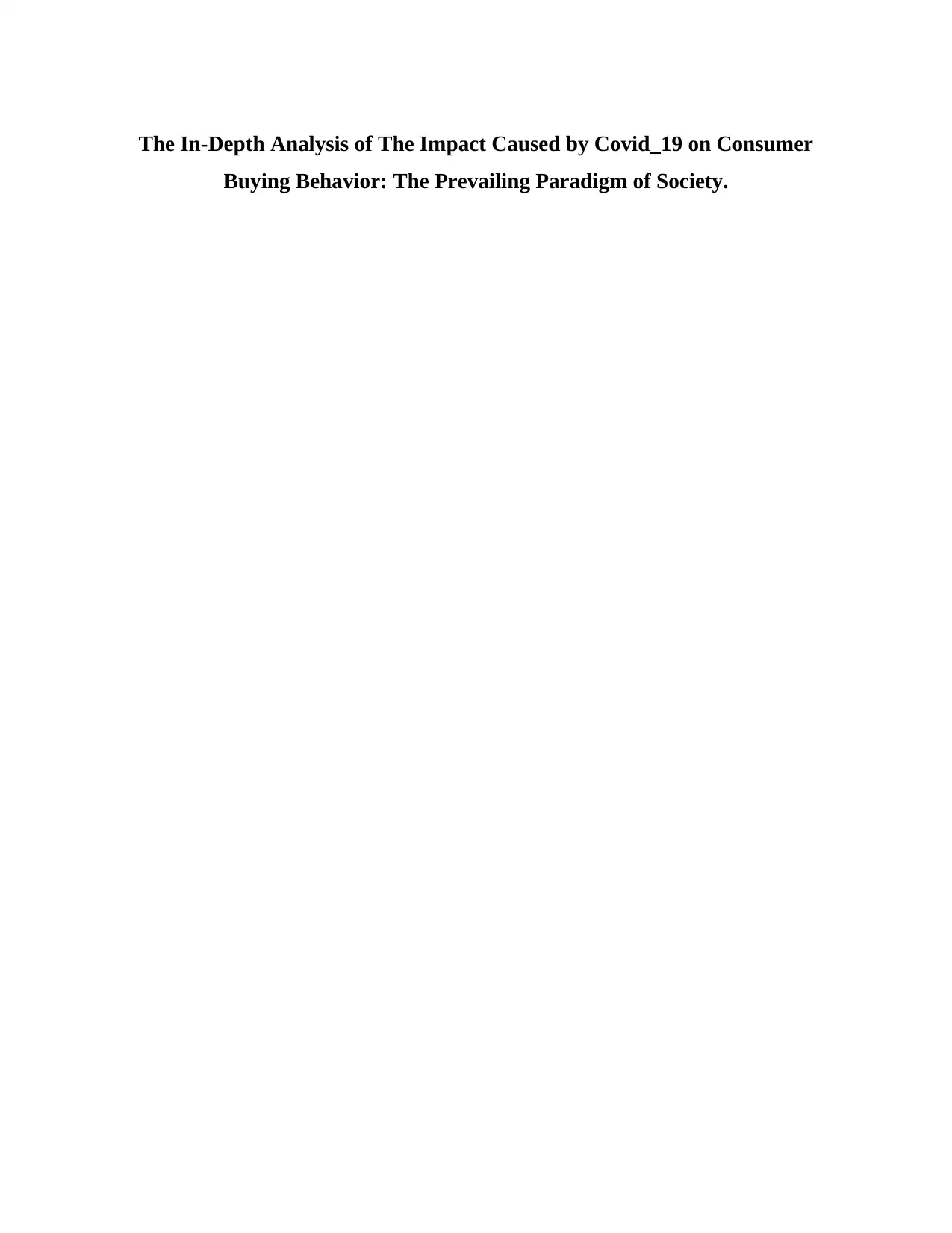
The In-Depth Analysis of The Impact Caused by Covid_19 on Consumer
Buying Behavior: The Prevailing Paradigm of Society.
Buying Behavior: The Prevailing Paradigm of Society.
Secure Best Marks with AI Grader
Need help grading? Try our AI Grader for instant feedback on your assignments.
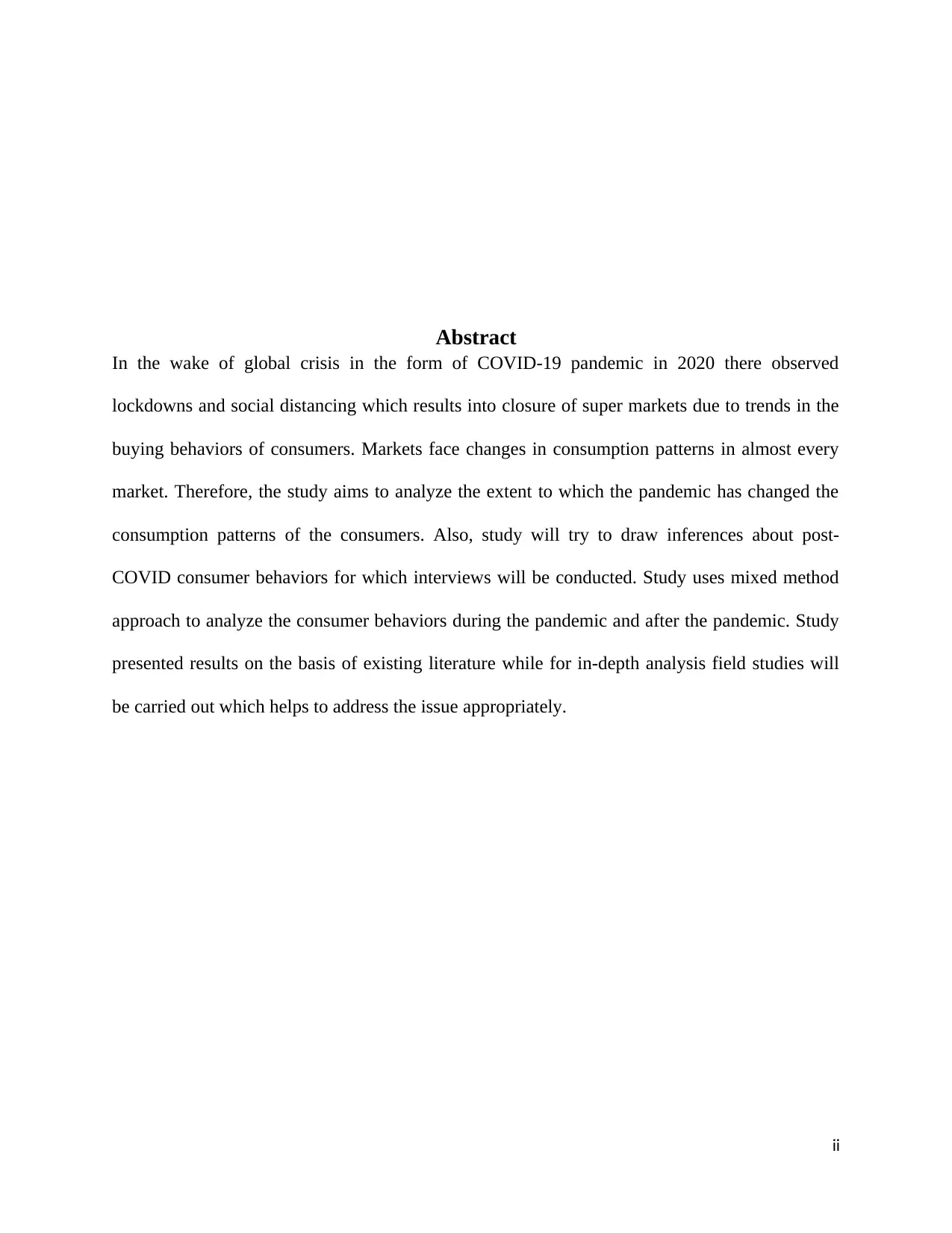
Abstract
In the wake of global crisis in the form of COVID-19 pandemic in 2020 there observed
lockdowns and social distancing which results into closure of super markets due to trends in the
buying behaviors of consumers. Markets face changes in consumption patterns in almost every
market. Therefore, the study aims to analyze the extent to which the pandemic has changed the
consumption patterns of the consumers. Also, study will try to draw inferences about post-
COVID consumer behaviors for which interviews will be conducted. Study uses mixed method
approach to analyze the consumer behaviors during the pandemic and after the pandemic. Study
presented results on the basis of existing literature while for in-depth analysis field studies will
be carried out which helps to address the issue appropriately.
ii
In the wake of global crisis in the form of COVID-19 pandemic in 2020 there observed
lockdowns and social distancing which results into closure of super markets due to trends in the
buying behaviors of consumers. Markets face changes in consumption patterns in almost every
market. Therefore, the study aims to analyze the extent to which the pandemic has changed the
consumption patterns of the consumers. Also, study will try to draw inferences about post-
COVID consumer behaviors for which interviews will be conducted. Study uses mixed method
approach to analyze the consumer behaviors during the pandemic and after the pandemic. Study
presented results on the basis of existing literature while for in-depth analysis field studies will
be carried out which helps to address the issue appropriately.
ii

Table of Contents
Abstract............................................................................................................................................ii
Chapter 1..........................................................................................................................................1
Introduction......................................................................................................................................1
1. Introduction...........................................................................................................................1
1.1 Background of the study................................................................................................2
1.2 Problem Statement........................................................................................................3
1.3 Research Questions.......................................................................................................3
1.4 Research Aim and Objectives.......................................................................................3
1.5 Significance...................................................................................................................4
1.6 Limitations.....................................................................................................................5
Chapter 2..........................................................................................................................................6
Literature Review............................................................................................................................6
2.1 Introduction.......................................................................................................................6
2.2 Empirical Framework.......................................................................................................6
2.2 Theoretical framework......................................................................................................7
Chapter 3..........................................................................................................................................9
Research Methodology....................................................................................................................9
3.1 Introduction.......................................................................................................................9
3.2 Research Methodology.....................................................................................................9
3.3 Research Philosophy.........................................................................................................9
3.4 Research Approach...........................................................................................................9
3.5 Research Purpose............................................................................................................10
3.6 Research Design..............................................................................................................10
3.7 Target Population............................................................................................................10
iii
Abstract............................................................................................................................................ii
Chapter 1..........................................................................................................................................1
Introduction......................................................................................................................................1
1. Introduction...........................................................................................................................1
1.1 Background of the study................................................................................................2
1.2 Problem Statement........................................................................................................3
1.3 Research Questions.......................................................................................................3
1.4 Research Aim and Objectives.......................................................................................3
1.5 Significance...................................................................................................................4
1.6 Limitations.....................................................................................................................5
Chapter 2..........................................................................................................................................6
Literature Review............................................................................................................................6
2.1 Introduction.......................................................................................................................6
2.2 Empirical Framework.......................................................................................................6
2.2 Theoretical framework......................................................................................................7
Chapter 3..........................................................................................................................................9
Research Methodology....................................................................................................................9
3.1 Introduction.......................................................................................................................9
3.2 Research Methodology.....................................................................................................9
3.3 Research Philosophy.........................................................................................................9
3.4 Research Approach...........................................................................................................9
3.5 Research Purpose............................................................................................................10
3.6 Research Design..............................................................................................................10
3.7 Target Population............................................................................................................10
iii
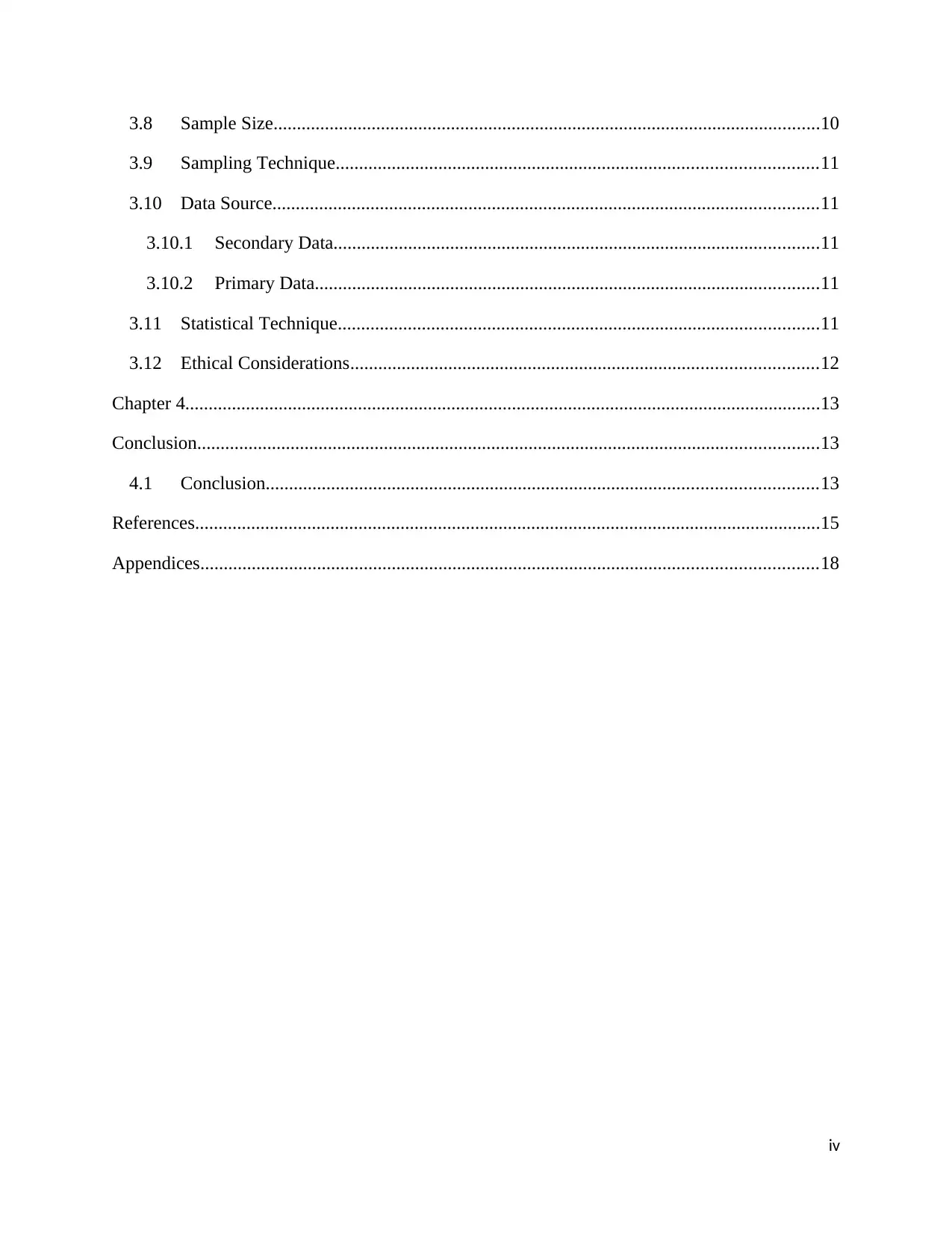
3.8 Sample Size.....................................................................................................................10
3.9 Sampling Technique.......................................................................................................11
3.10 Data Source.....................................................................................................................11
3.10.1 Secondary Data........................................................................................................11
3.10.2 Primary Data............................................................................................................11
3.11 Statistical Technique.......................................................................................................11
3.12 Ethical Considerations....................................................................................................12
Chapter 4........................................................................................................................................13
Conclusion.....................................................................................................................................13
4.1 Conclusion......................................................................................................................13
References......................................................................................................................................15
Appendices....................................................................................................................................18
iv
3.9 Sampling Technique.......................................................................................................11
3.10 Data Source.....................................................................................................................11
3.10.1 Secondary Data........................................................................................................11
3.10.2 Primary Data............................................................................................................11
3.11 Statistical Technique.......................................................................................................11
3.12 Ethical Considerations....................................................................................................12
Chapter 4........................................................................................................................................13
Conclusion.....................................................................................................................................13
4.1 Conclusion......................................................................................................................13
References......................................................................................................................................15
Appendices....................................................................................................................................18
iv
Secure Best Marks with AI Grader
Need help grading? Try our AI Grader for instant feedback on your assignments.
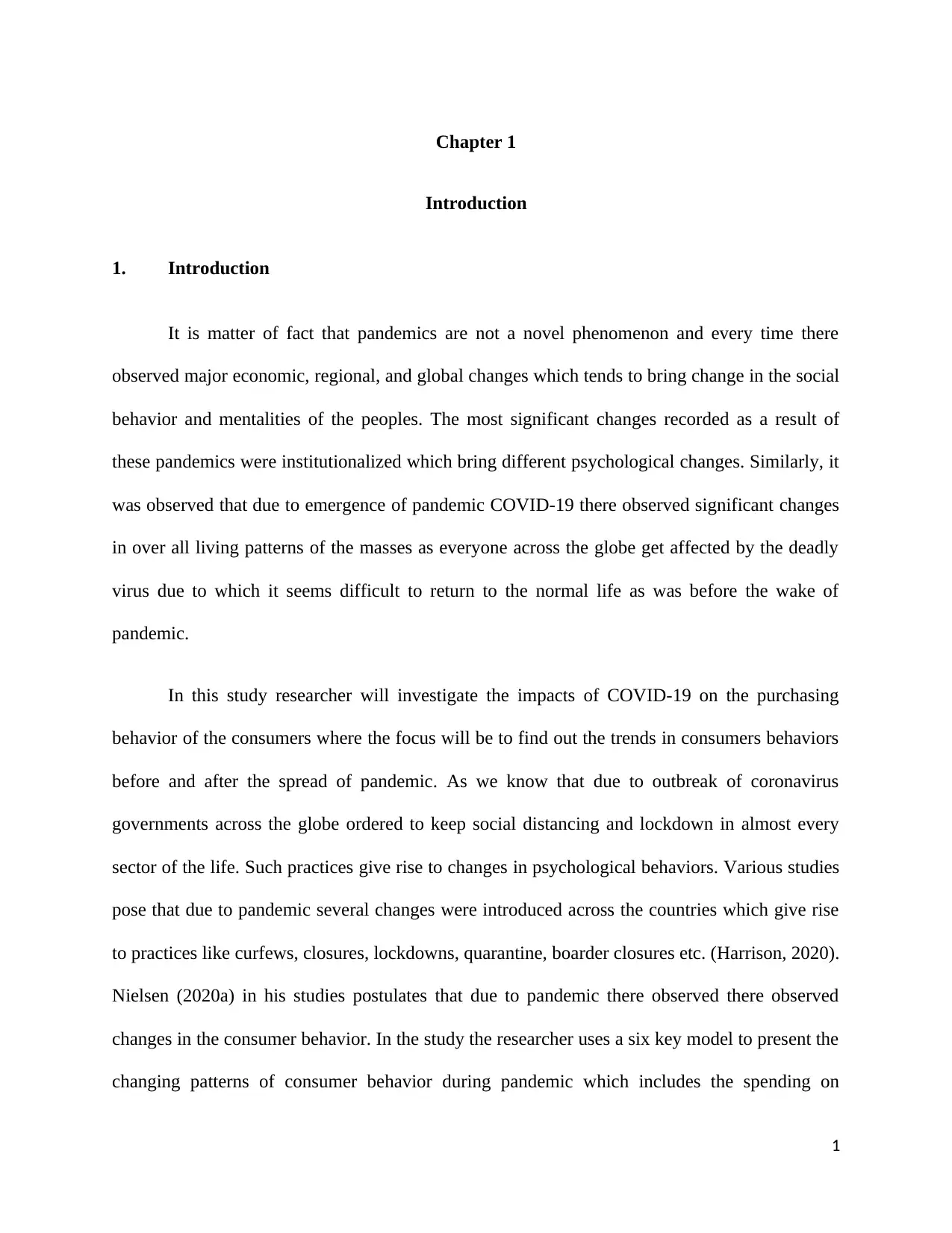
Chapter 1
Introduction
1. Introduction
It is matter of fact that pandemics are not a novel phenomenon and every time there
observed major economic, regional, and global changes which tends to bring change in the social
behavior and mentalities of the peoples. The most significant changes recorded as a result of
these pandemics were institutionalized which bring different psychological changes. Similarly, it
was observed that due to emergence of pandemic COVID-19 there observed significant changes
in over all living patterns of the masses as everyone across the globe get affected by the deadly
virus due to which it seems difficult to return to the normal life as was before the wake of
pandemic.
In this study researcher will investigate the impacts of COVID-19 on the purchasing
behavior of the consumers where the focus will be to find out the trends in consumers behaviors
before and after the spread of pandemic. As we know that due to outbreak of coronavirus
governments across the globe ordered to keep social distancing and lockdown in almost every
sector of the life. Such practices give rise to changes in psychological behaviors. Various studies
pose that due to pandemic several changes were introduced across the countries which give rise
to practices like curfews, closures, lockdowns, quarantine, boarder closures etc. (Harrison, 2020).
Nielsen (2020a) in his studies postulates that due to pandemic there observed there observed
changes in the consumer behavior. In the study the researcher uses a six key model to present the
changing patterns of consumer behavior during pandemic which includes the spending on
1
Introduction
1. Introduction
It is matter of fact that pandemics are not a novel phenomenon and every time there
observed major economic, regional, and global changes which tends to bring change in the social
behavior and mentalities of the peoples. The most significant changes recorded as a result of
these pandemics were institutionalized which bring different psychological changes. Similarly, it
was observed that due to emergence of pandemic COVID-19 there observed significant changes
in over all living patterns of the masses as everyone across the globe get affected by the deadly
virus due to which it seems difficult to return to the normal life as was before the wake of
pandemic.
In this study researcher will investigate the impacts of COVID-19 on the purchasing
behavior of the consumers where the focus will be to find out the trends in consumers behaviors
before and after the spread of pandemic. As we know that due to outbreak of coronavirus
governments across the globe ordered to keep social distancing and lockdown in almost every
sector of the life. Such practices give rise to changes in psychological behaviors. Various studies
pose that due to pandemic several changes were introduced across the countries which give rise
to practices like curfews, closures, lockdowns, quarantine, boarder closures etc. (Harrison, 2020).
Nielsen (2020a) in his studies postulates that due to pandemic there observed there observed
changes in the consumer behavior. In the study the researcher uses a six key model to present the
changing patterns of consumer behavior during pandemic which includes the spending on
1
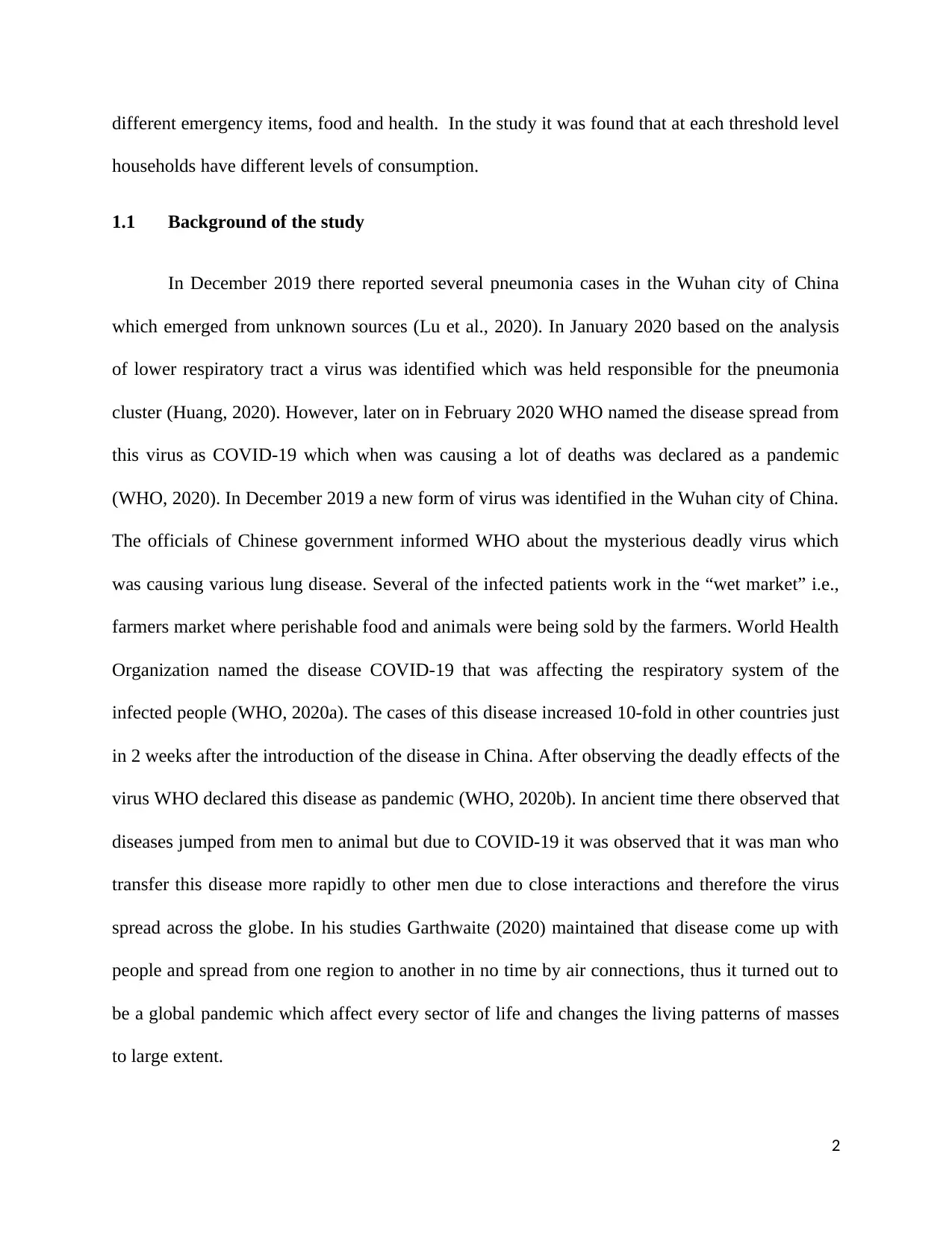
different emergency items, food and health. In the study it was found that at each threshold level
households have different levels of consumption.
1.1 Background of the study
In December 2019 there reported several pneumonia cases in the Wuhan city of China
which emerged from unknown sources (Lu et al., 2020). In January 2020 based on the analysis
of lower respiratory tract a virus was identified which was held responsible for the pneumonia
cluster (Huang, 2020). However, later on in February 2020 WHO named the disease spread from
this virus as COVID-19 which when was causing a lot of deaths was declared as a pandemic
(WHO, 2020). In December 2019 a new form of virus was identified in the Wuhan city of China.
The officials of Chinese government informed WHO about the mysterious deadly virus which
was causing various lung disease. Several of the infected patients work in the “wet market” i.e.,
farmers market where perishable food and animals were being sold by the farmers. World Health
Organization named the disease COVID-19 that was affecting the respiratory system of the
infected people (WHO, 2020a). The cases of this disease increased 10-fold in other countries just
in 2 weeks after the introduction of the disease in China. After observing the deadly effects of the
virus WHO declared this disease as pandemic (WHO, 2020b). In ancient time there observed that
diseases jumped from men to animal but due to COVID-19 it was observed that it was man who
transfer this disease more rapidly to other men due to close interactions and therefore the virus
spread across the globe. In his studies Garthwaite (2020) maintained that disease come up with
people and spread from one region to another in no time by air connections, thus it turned out to
be a global pandemic which affect every sector of life and changes the living patterns of masses
to large extent.
2
households have different levels of consumption.
1.1 Background of the study
In December 2019 there reported several pneumonia cases in the Wuhan city of China
which emerged from unknown sources (Lu et al., 2020). In January 2020 based on the analysis
of lower respiratory tract a virus was identified which was held responsible for the pneumonia
cluster (Huang, 2020). However, later on in February 2020 WHO named the disease spread from
this virus as COVID-19 which when was causing a lot of deaths was declared as a pandemic
(WHO, 2020). In December 2019 a new form of virus was identified in the Wuhan city of China.
The officials of Chinese government informed WHO about the mysterious deadly virus which
was causing various lung disease. Several of the infected patients work in the “wet market” i.e.,
farmers market where perishable food and animals were being sold by the farmers. World Health
Organization named the disease COVID-19 that was affecting the respiratory system of the
infected people (WHO, 2020a). The cases of this disease increased 10-fold in other countries just
in 2 weeks after the introduction of the disease in China. After observing the deadly effects of the
virus WHO declared this disease as pandemic (WHO, 2020b). In ancient time there observed that
diseases jumped from men to animal but due to COVID-19 it was observed that it was man who
transfer this disease more rapidly to other men due to close interactions and therefore the virus
spread across the globe. In his studies Garthwaite (2020) maintained that disease come up with
people and spread from one region to another in no time by air connections, thus it turned out to
be a global pandemic which affect every sector of life and changes the living patterns of masses
to large extent.
2
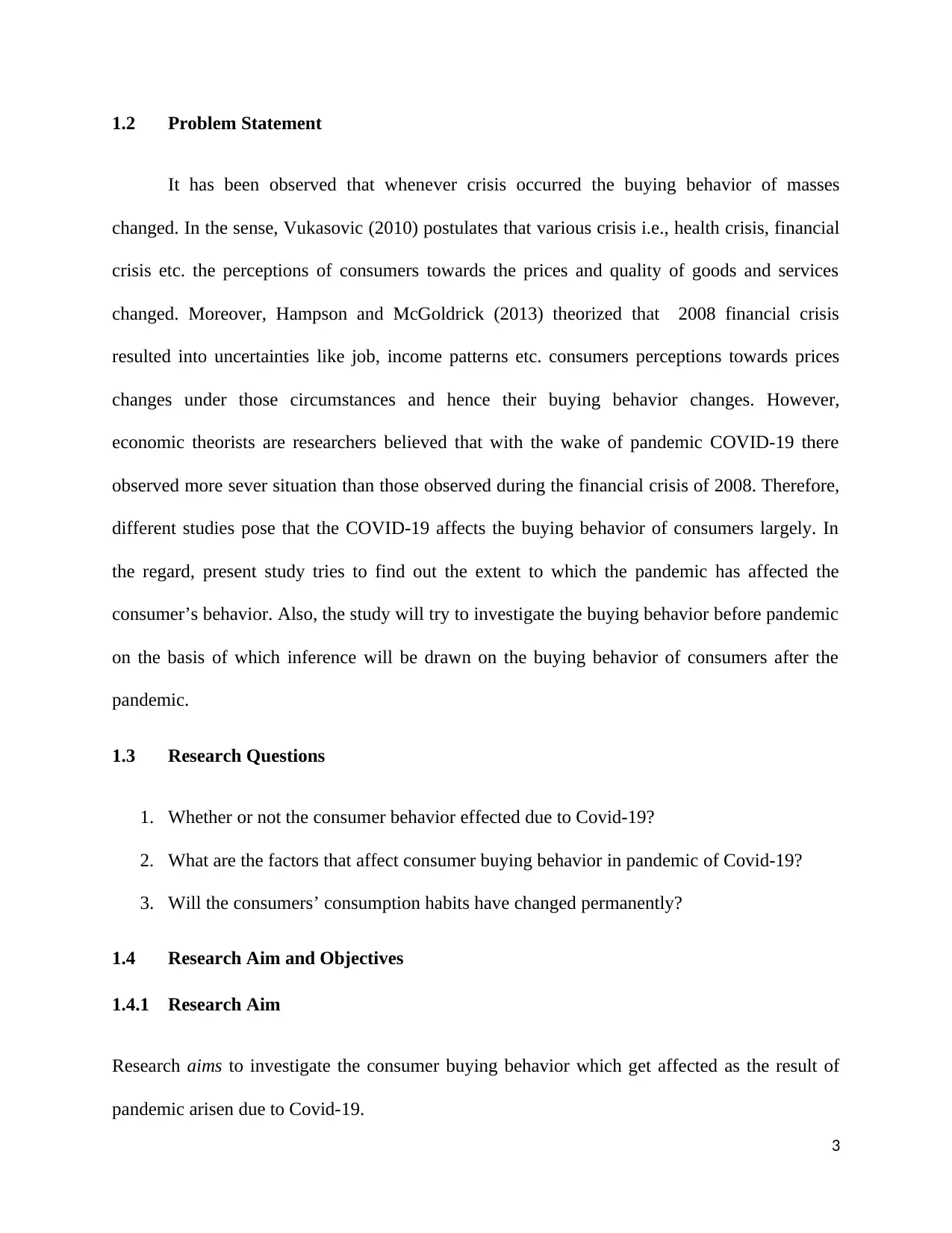
1.2 Problem Statement
It has been observed that whenever crisis occurred the buying behavior of masses
changed. In the sense, Vukasovic (2010) postulates that various crisis i.e., health crisis, financial
crisis etc. the perceptions of consumers towards the prices and quality of goods and services
changed. Moreover, Hampson and McGoldrick (2013) theorized that 2008 financial crisis
resulted into uncertainties like job, income patterns etc. consumers perceptions towards prices
changes under those circumstances and hence their buying behavior changes. However,
economic theorists are researchers believed that with the wake of pandemic COVID-19 there
observed more sever situation than those observed during the financial crisis of 2008. Therefore,
different studies pose that the COVID-19 affects the buying behavior of consumers largely. In
the regard, present study tries to find out the extent to which the pandemic has affected the
consumer’s behavior. Also, the study will try to investigate the buying behavior before pandemic
on the basis of which inference will be drawn on the buying behavior of consumers after the
pandemic.
1.3 Research Questions
1. Whether or not the consumer behavior effected due to Covid-19?
2. What are the factors that affect consumer buying behavior in pandemic of Covid-19?
3. Will the consumers’ consumption habits have changed permanently?
1.4 Research Aim and Objectives
1.4.1 Research Aim
Research aims to investigate the consumer buying behavior which get affected as the result of
pandemic arisen due to Covid-19.
3
It has been observed that whenever crisis occurred the buying behavior of masses
changed. In the sense, Vukasovic (2010) postulates that various crisis i.e., health crisis, financial
crisis etc. the perceptions of consumers towards the prices and quality of goods and services
changed. Moreover, Hampson and McGoldrick (2013) theorized that 2008 financial crisis
resulted into uncertainties like job, income patterns etc. consumers perceptions towards prices
changes under those circumstances and hence their buying behavior changes. However,
economic theorists are researchers believed that with the wake of pandemic COVID-19 there
observed more sever situation than those observed during the financial crisis of 2008. Therefore,
different studies pose that the COVID-19 affects the buying behavior of consumers largely. In
the regard, present study tries to find out the extent to which the pandemic has affected the
consumer’s behavior. Also, the study will try to investigate the buying behavior before pandemic
on the basis of which inference will be drawn on the buying behavior of consumers after the
pandemic.
1.3 Research Questions
1. Whether or not the consumer behavior effected due to Covid-19?
2. What are the factors that affect consumer buying behavior in pandemic of Covid-19?
3. Will the consumers’ consumption habits have changed permanently?
1.4 Research Aim and Objectives
1.4.1 Research Aim
Research aims to investigate the consumer buying behavior which get affected as the result of
pandemic arisen due to Covid-19.
3
Paraphrase This Document
Need a fresh take? Get an instant paraphrase of this document with our AI Paraphraser
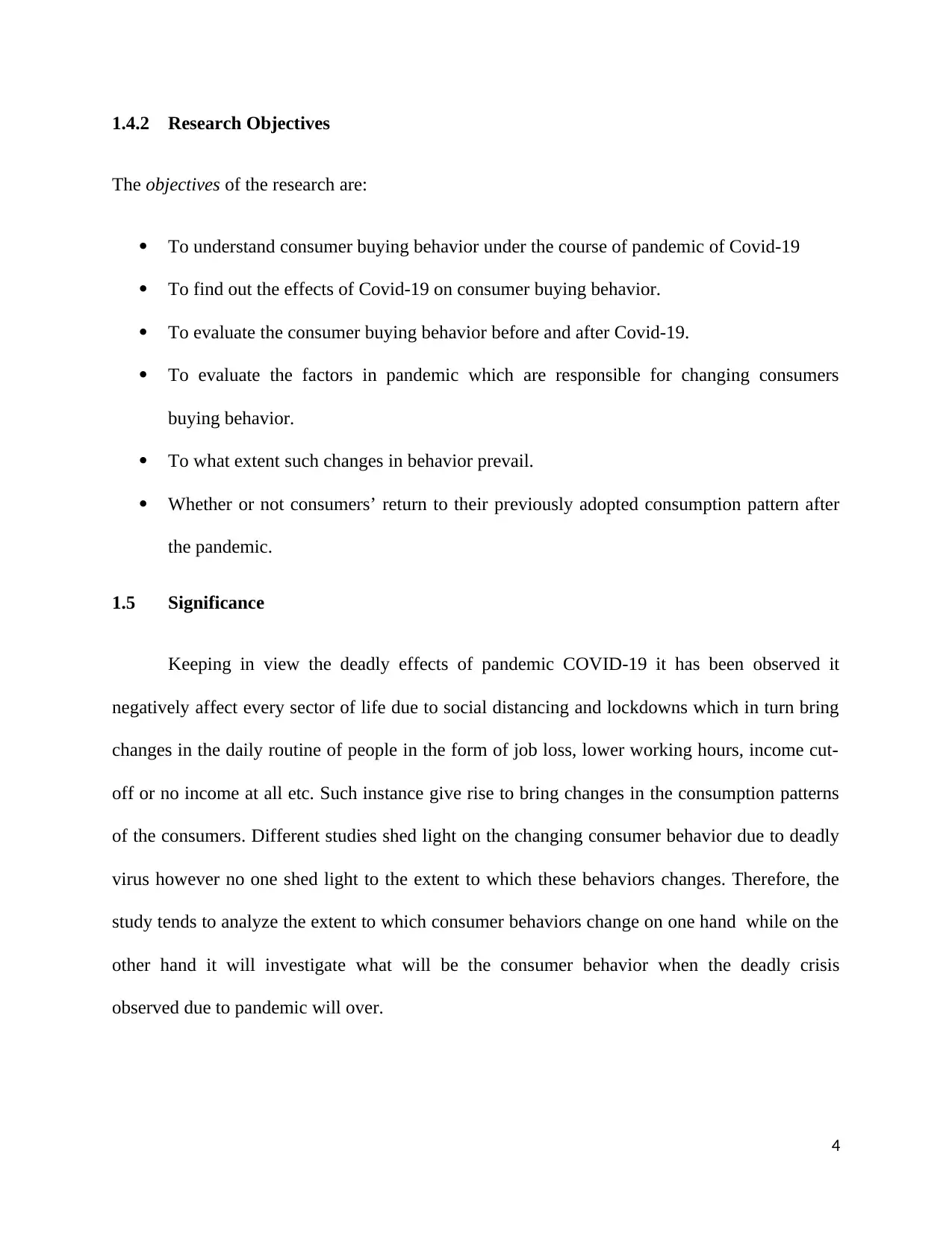
1.4.2 Research Objectives
The objectives of the research are:
To understand consumer buying behavior under the course of pandemic of Covid-19
To find out the effects of Covid-19 on consumer buying behavior.
To evaluate the consumer buying behavior before and after Covid-19.
To evaluate the factors in pandemic which are responsible for changing consumers
buying behavior.
To what extent such changes in behavior prevail.
Whether or not consumers’ return to their previously adopted consumption pattern after
the pandemic.
1.5 Significance
Keeping in view the deadly effects of pandemic COVID-19 it has been observed it
negatively affect every sector of life due to social distancing and lockdowns which in turn bring
changes in the daily routine of people in the form of job loss, lower working hours, income cut-
off or no income at all etc. Such instance give rise to bring changes in the consumption patterns
of the consumers. Different studies shed light on the changing consumer behavior due to deadly
virus however no one shed light to the extent to which these behaviors changes. Therefore, the
study tends to analyze the extent to which consumer behaviors change on one hand while on the
other hand it will investigate what will be the consumer behavior when the deadly crisis
observed due to pandemic will over.
4
The objectives of the research are:
To understand consumer buying behavior under the course of pandemic of Covid-19
To find out the effects of Covid-19 on consumer buying behavior.
To evaluate the consumer buying behavior before and after Covid-19.
To evaluate the factors in pandemic which are responsible for changing consumers
buying behavior.
To what extent such changes in behavior prevail.
Whether or not consumers’ return to their previously adopted consumption pattern after
the pandemic.
1.5 Significance
Keeping in view the deadly effects of pandemic COVID-19 it has been observed it
negatively affect every sector of life due to social distancing and lockdowns which in turn bring
changes in the daily routine of people in the form of job loss, lower working hours, income cut-
off or no income at all etc. Such instance give rise to bring changes in the consumption patterns
of the consumers. Different studies shed light on the changing consumer behavior due to deadly
virus however no one shed light to the extent to which these behaviors changes. Therefore, the
study tends to analyze the extent to which consumer behaviors change on one hand while on the
other hand it will investigate what will be the consumer behavior when the deadly crisis
observed due to pandemic will over.
4
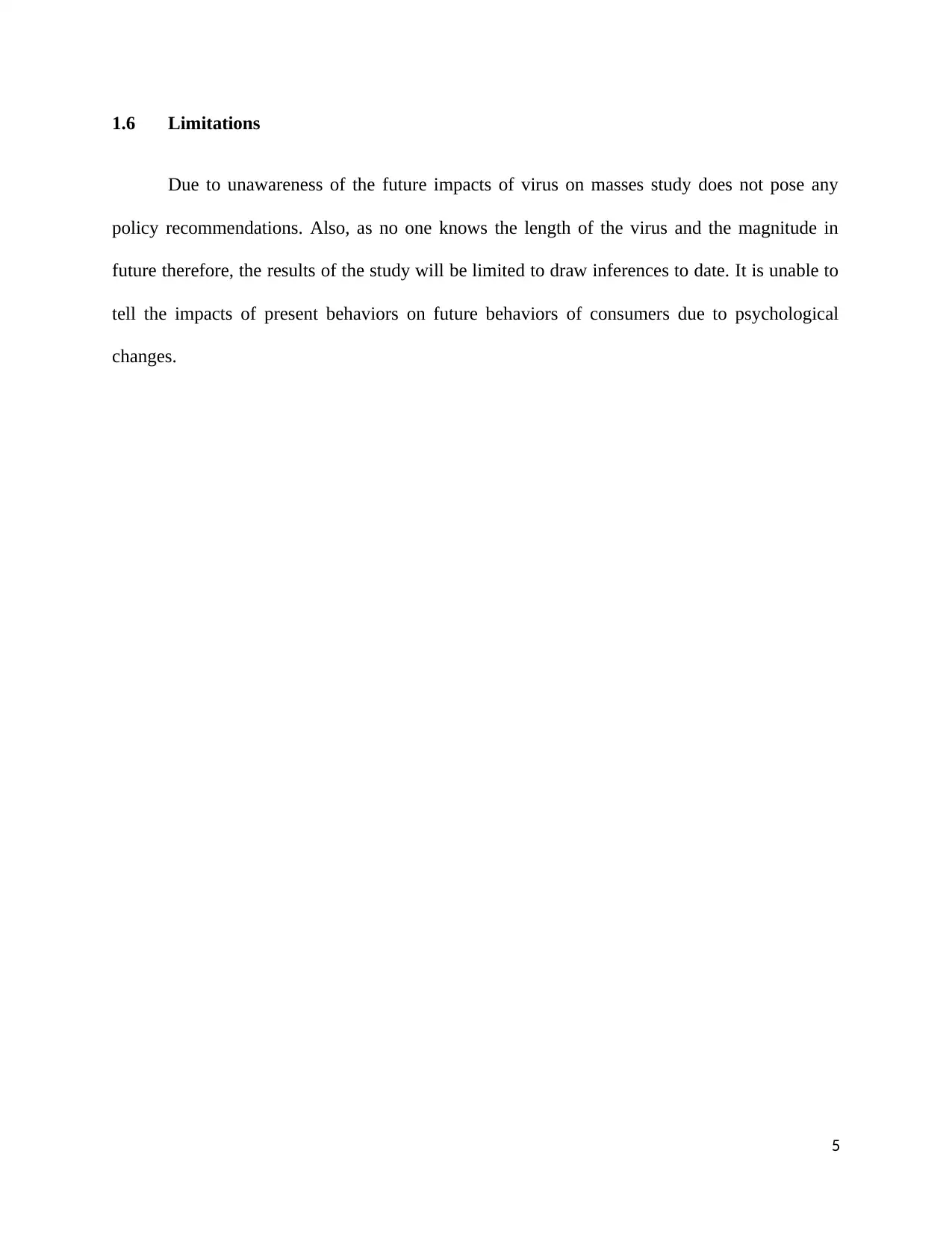
1.6 Limitations
Due to unawareness of the future impacts of virus on masses study does not pose any
policy recommendations. Also, as no one knows the length of the virus and the magnitude in
future therefore, the results of the study will be limited to draw inferences to date. It is unable to
tell the impacts of present behaviors on future behaviors of consumers due to psychological
changes.
5
Due to unawareness of the future impacts of virus on masses study does not pose any
policy recommendations. Also, as no one knows the length of the virus and the magnitude in
future therefore, the results of the study will be limited to draw inferences to date. It is unable to
tell the impacts of present behaviors on future behaviors of consumers due to psychological
changes.
5
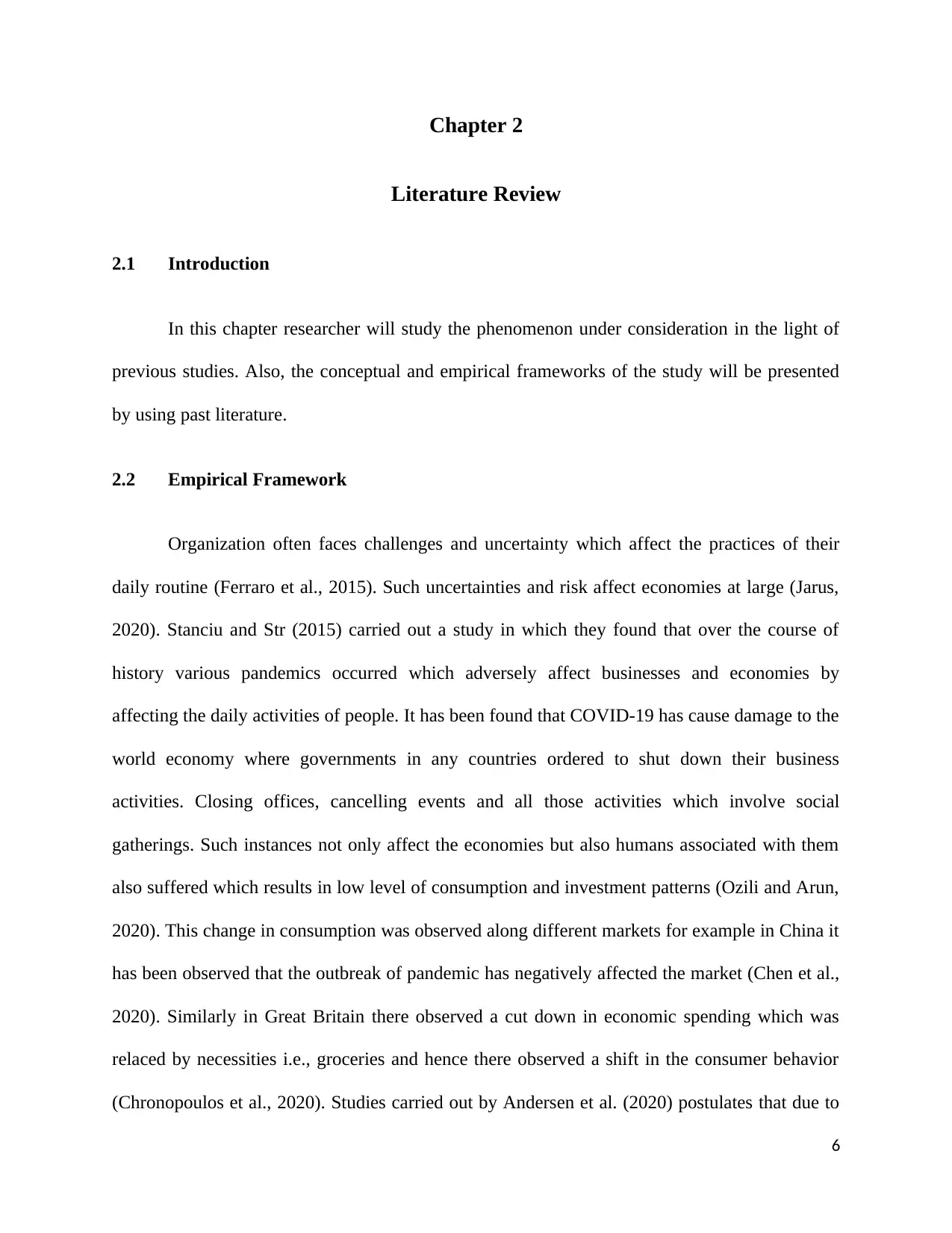
Chapter 2
Literature Review
2.1 Introduction
In this chapter researcher will study the phenomenon under consideration in the light of
previous studies. Also, the conceptual and empirical frameworks of the study will be presented
by using past literature.
2.2 Empirical Framework
Organization often faces challenges and uncertainty which affect the practices of their
daily routine (Ferraro et al., 2015). Such uncertainties and risk affect economies at large (Jarus,
2020). Stanciu and Str (2015) carried out a study in which they found that over the course of
history various pandemics occurred which adversely affect businesses and economies by
affecting the daily activities of people. It has been found that COVID-19 has cause damage to the
world economy where governments in any countries ordered to shut down their business
activities. Closing offices, cancelling events and all those activities which involve social
gatherings. Such instances not only affect the economies but also humans associated with them
also suffered which results in low level of consumption and investment patterns (Ozili and Arun,
2020). This change in consumption was observed along different markets for example in China it
has been observed that the outbreak of pandemic has negatively affected the market (Chen et al.,
2020). Similarly in Great Britain there observed a cut down in economic spending which was
relaced by necessities i.e., groceries and hence there observed a shift in the consumer behavior
(Chronopoulos et al., 2020). Studies carried out by Andersen et al. (2020) postulates that due to
6
Literature Review
2.1 Introduction
In this chapter researcher will study the phenomenon under consideration in the light of
previous studies. Also, the conceptual and empirical frameworks of the study will be presented
by using past literature.
2.2 Empirical Framework
Organization often faces challenges and uncertainty which affect the practices of their
daily routine (Ferraro et al., 2015). Such uncertainties and risk affect economies at large (Jarus,
2020). Stanciu and Str (2015) carried out a study in which they found that over the course of
history various pandemics occurred which adversely affect businesses and economies by
affecting the daily activities of people. It has been found that COVID-19 has cause damage to the
world economy where governments in any countries ordered to shut down their business
activities. Closing offices, cancelling events and all those activities which involve social
gatherings. Such instances not only affect the economies but also humans associated with them
also suffered which results in low level of consumption and investment patterns (Ozili and Arun,
2020). This change in consumption was observed along different markets for example in China it
has been observed that the outbreak of pandemic has negatively affected the market (Chen et al.,
2020). Similarly in Great Britain there observed a cut down in economic spending which was
relaced by necessities i.e., groceries and hence there observed a shift in the consumer behavior
(Chronopoulos et al., 2020). Studies carried out by Andersen et al. (2020) postulates that due to
6
Secure Best Marks with AI Grader
Need help grading? Try our AI Grader for instant feedback on your assignments.
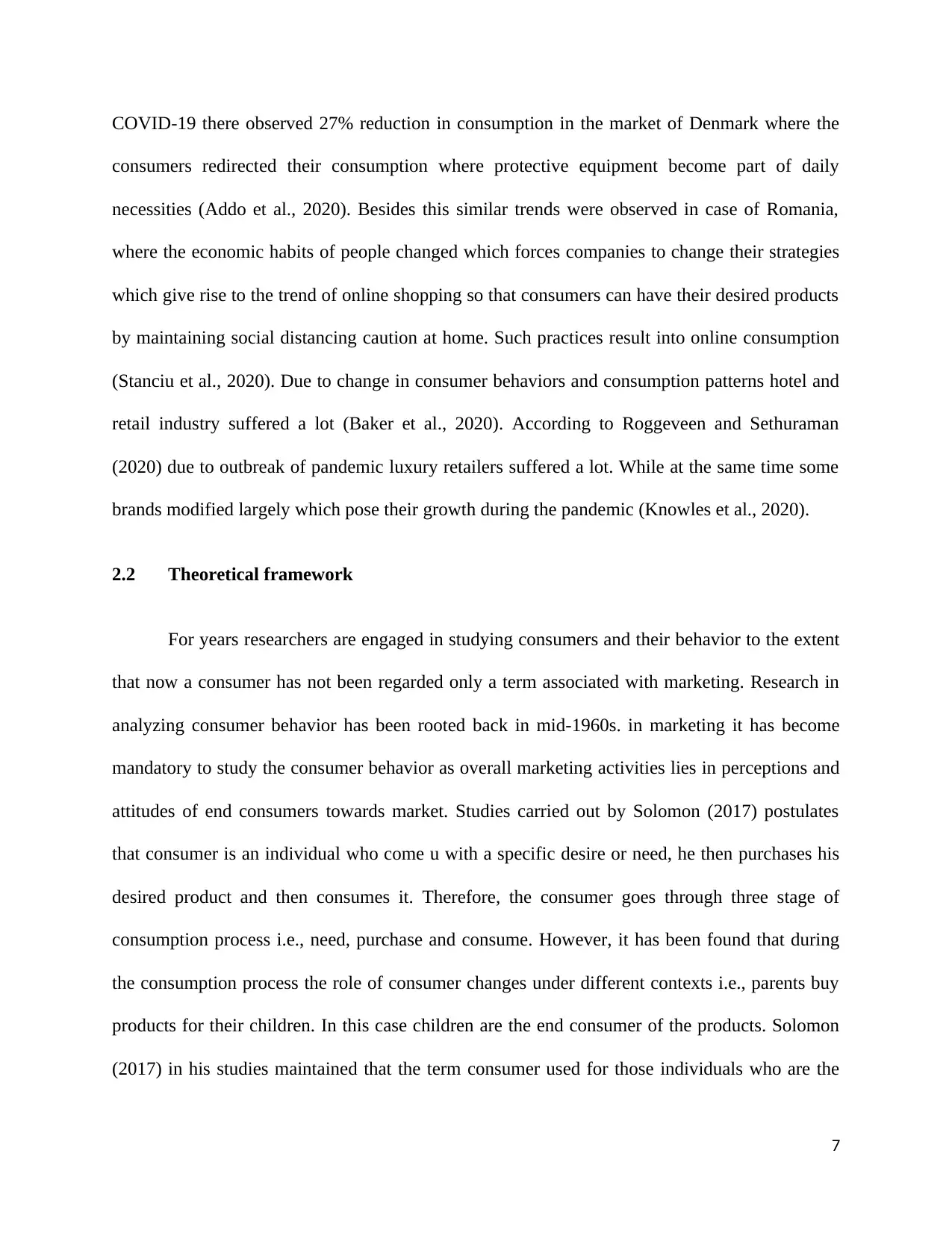
COVID-19 there observed 27% reduction in consumption in the market of Denmark where the
consumers redirected their consumption where protective equipment become part of daily
necessities (Addo et al., 2020). Besides this similar trends were observed in case of Romania,
where the economic habits of people changed which forces companies to change their strategies
which give rise to the trend of online shopping so that consumers can have their desired products
by maintaining social distancing caution at home. Such practices result into online consumption
(Stanciu et al., 2020). Due to change in consumer behaviors and consumption patterns hotel and
retail industry suffered a lot (Baker et al., 2020). According to Roggeveen and Sethuraman
(2020) due to outbreak of pandemic luxury retailers suffered a lot. While at the same time some
brands modified largely which pose their growth during the pandemic (Knowles et al., 2020).
2.2 Theoretical framework
For years researchers are engaged in studying consumers and their behavior to the extent
that now a consumer has not been regarded only a term associated with marketing. Research in
analyzing consumer behavior has been rooted back in mid-1960s. in marketing it has become
mandatory to study the consumer behavior as overall marketing activities lies in perceptions and
attitudes of end consumers towards market. Studies carried out by Solomon (2017) postulates
that consumer is an individual who come u with a specific desire or need, he then purchases his
desired product and then consumes it. Therefore, the consumer goes through three stage of
consumption process i.e., need, purchase and consume. However, it has been found that during
the consumption process the role of consumer changes under different contexts i.e., parents buy
products for their children. In this case children are the end consumer of the products. Solomon
(2017) in his studies maintained that the term consumer used for those individuals who are the
7
consumers redirected their consumption where protective equipment become part of daily
necessities (Addo et al., 2020). Besides this similar trends were observed in case of Romania,
where the economic habits of people changed which forces companies to change their strategies
which give rise to the trend of online shopping so that consumers can have their desired products
by maintaining social distancing caution at home. Such practices result into online consumption
(Stanciu et al., 2020). Due to change in consumer behaviors and consumption patterns hotel and
retail industry suffered a lot (Baker et al., 2020). According to Roggeveen and Sethuraman
(2020) due to outbreak of pandemic luxury retailers suffered a lot. While at the same time some
brands modified largely which pose their growth during the pandemic (Knowles et al., 2020).
2.2 Theoretical framework
For years researchers are engaged in studying consumers and their behavior to the extent
that now a consumer has not been regarded only a term associated with marketing. Research in
analyzing consumer behavior has been rooted back in mid-1960s. in marketing it has become
mandatory to study the consumer behavior as overall marketing activities lies in perceptions and
attitudes of end consumers towards market. Studies carried out by Solomon (2017) postulates
that consumer is an individual who come u with a specific desire or need, he then purchases his
desired product and then consumes it. Therefore, the consumer goes through three stage of
consumption process i.e., need, purchase and consume. However, it has been found that during
the consumption process the role of consumer changes under different contexts i.e., parents buy
products for their children. In this case children are the end consumer of the products. Solomon
(2017) in his studies maintained that the term consumer used for those individuals who are the
7
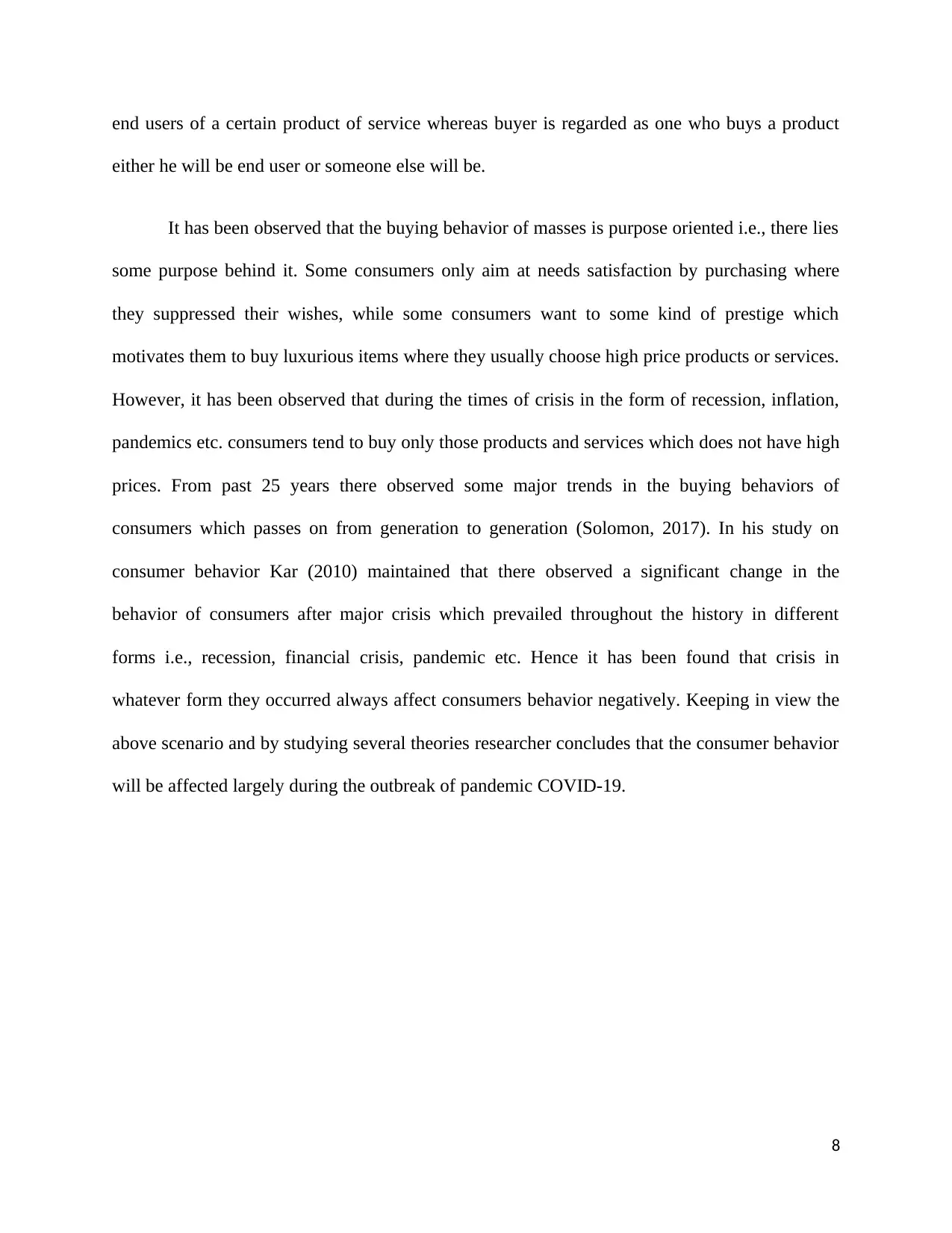
end users of a certain product of service whereas buyer is regarded as one who buys a product
either he will be end user or someone else will be.
It has been observed that the buying behavior of masses is purpose oriented i.e., there lies
some purpose behind it. Some consumers only aim at needs satisfaction by purchasing where
they suppressed their wishes, while some consumers want to some kind of prestige which
motivates them to buy luxurious items where they usually choose high price products or services.
However, it has been observed that during the times of crisis in the form of recession, inflation,
pandemics etc. consumers tend to buy only those products and services which does not have high
prices. From past 25 years there observed some major trends in the buying behaviors of
consumers which passes on from generation to generation (Solomon, 2017). In his study on
consumer behavior Kar (2010) maintained that there observed a significant change in the
behavior of consumers after major crisis which prevailed throughout the history in different
forms i.e., recession, financial crisis, pandemic etc. Hence it has been found that crisis in
whatever form they occurred always affect consumers behavior negatively. Keeping in view the
above scenario and by studying several theories researcher concludes that the consumer behavior
will be affected largely during the outbreak of pandemic COVID-19.
8
either he will be end user or someone else will be.
It has been observed that the buying behavior of masses is purpose oriented i.e., there lies
some purpose behind it. Some consumers only aim at needs satisfaction by purchasing where
they suppressed their wishes, while some consumers want to some kind of prestige which
motivates them to buy luxurious items where they usually choose high price products or services.
However, it has been observed that during the times of crisis in the form of recession, inflation,
pandemics etc. consumers tend to buy only those products and services which does not have high
prices. From past 25 years there observed some major trends in the buying behaviors of
consumers which passes on from generation to generation (Solomon, 2017). In his study on
consumer behavior Kar (2010) maintained that there observed a significant change in the
behavior of consumers after major crisis which prevailed throughout the history in different
forms i.e., recession, financial crisis, pandemic etc. Hence it has been found that crisis in
whatever form they occurred always affect consumers behavior negatively. Keeping in view the
above scenario and by studying several theories researcher concludes that the consumer behavior
will be affected largely during the outbreak of pandemic COVID-19.
8
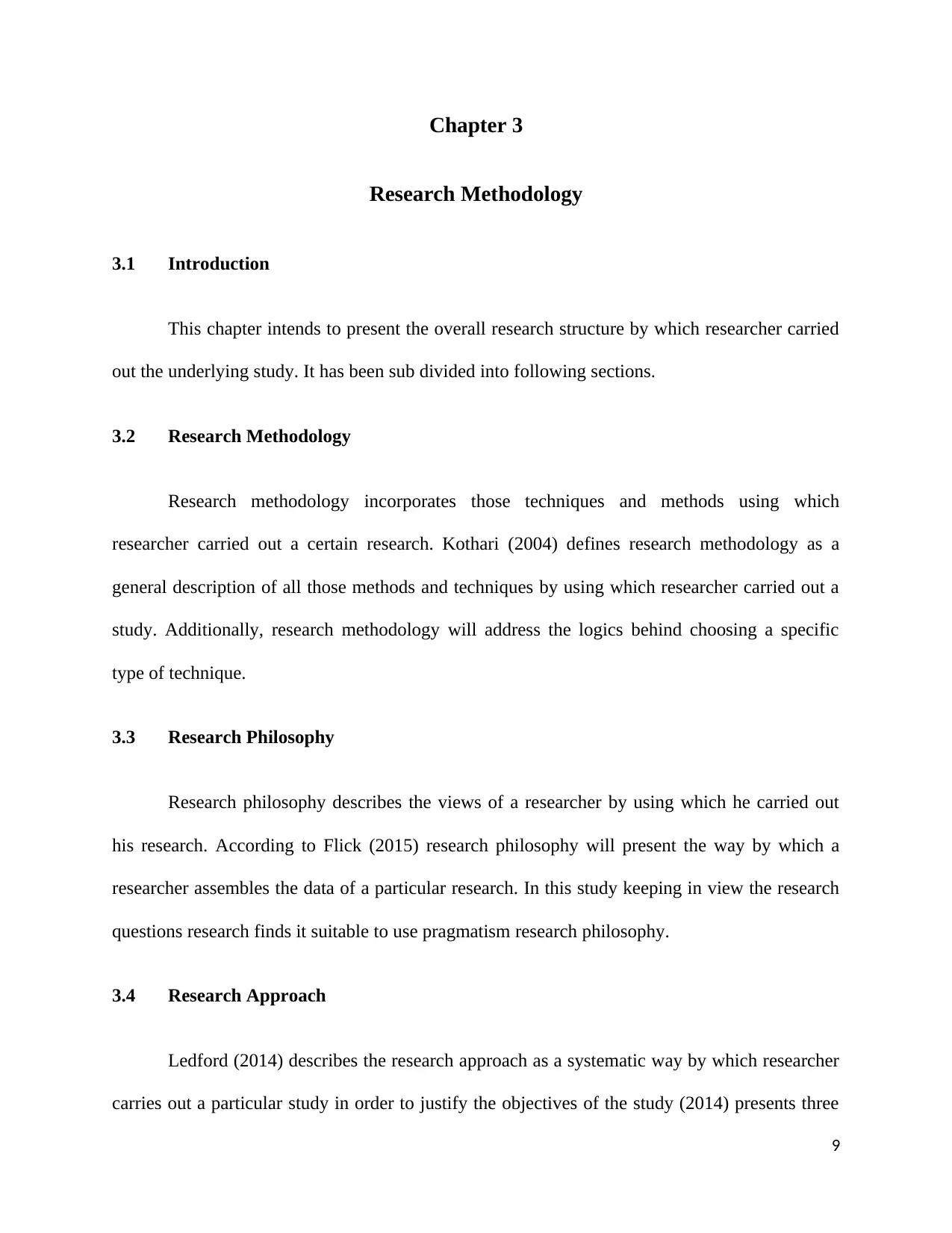
Chapter 3
Research Methodology
3.1 Introduction
This chapter intends to present the overall research structure by which researcher carried
out the underlying study. It has been sub divided into following sections.
3.2 Research Methodology
Research methodology incorporates those techniques and methods using which
researcher carried out a certain research. Kothari (2004) defines research methodology as a
general description of all those methods and techniques by using which researcher carried out a
study. Additionally, research methodology will address the logics behind choosing a specific
type of technique.
3.3 Research Philosophy
Research philosophy describes the views of a researcher by using which he carried out
his research. According to Flick (2015) research philosophy will present the way by which a
researcher assembles the data of a particular research. In this study keeping in view the research
questions research finds it suitable to use pragmatism research philosophy.
3.4 Research Approach
Ledford (2014) describes the research approach as a systematic way by which researcher
carries out a particular study in order to justify the objectives of the study (2014) presents three
9
Research Methodology
3.1 Introduction
This chapter intends to present the overall research structure by which researcher carried
out the underlying study. It has been sub divided into following sections.
3.2 Research Methodology
Research methodology incorporates those techniques and methods using which
researcher carried out a certain research. Kothari (2004) defines research methodology as a
general description of all those methods and techniques by using which researcher carried out a
study. Additionally, research methodology will address the logics behind choosing a specific
type of technique.
3.3 Research Philosophy
Research philosophy describes the views of a researcher by using which he carried out
his research. According to Flick (2015) research philosophy will present the way by which a
researcher assembles the data of a particular research. In this study keeping in view the research
questions research finds it suitable to use pragmatism research philosophy.
3.4 Research Approach
Ledford (2014) describes the research approach as a systematic way by which researcher
carries out a particular study in order to justify the objectives of the study (2014) presents three
9
Paraphrase This Document
Need a fresh take? Get an instant paraphrase of this document with our AI Paraphraser
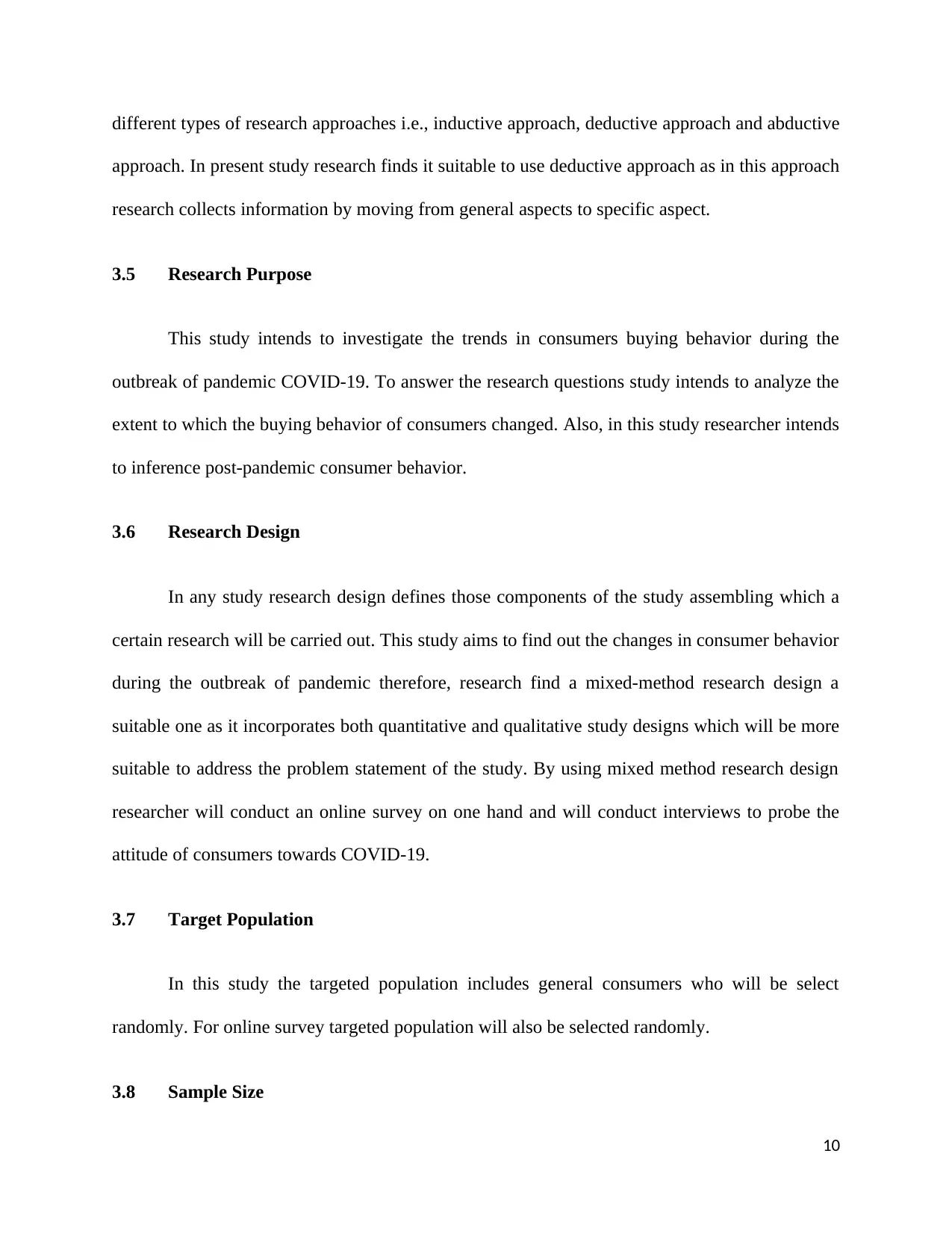
different types of research approaches i.e., inductive approach, deductive approach and abductive
approach. In present study research finds it suitable to use deductive approach as in this approach
research collects information by moving from general aspects to specific aspect.
3.5 Research Purpose
This study intends to investigate the trends in consumers buying behavior during the
outbreak of pandemic COVID-19. To answer the research questions study intends to analyze the
extent to which the buying behavior of consumers changed. Also, in this study researcher intends
to inference post-pandemic consumer behavior.
3.6 Research Design
In any study research design defines those components of the study assembling which a
certain research will be carried out. This study aims to find out the changes in consumer behavior
during the outbreak of pandemic therefore, research find a mixed-method research design a
suitable one as it incorporates both quantitative and qualitative study designs which will be more
suitable to address the problem statement of the study. By using mixed method research design
researcher will conduct an online survey on one hand and will conduct interviews to probe the
attitude of consumers towards COVID-19.
3.7 Target Population
In this study the targeted population includes general consumers who will be select
randomly. For online survey targeted population will also be selected randomly.
3.8 Sample Size
10
approach. In present study research finds it suitable to use deductive approach as in this approach
research collects information by moving from general aspects to specific aspect.
3.5 Research Purpose
This study intends to investigate the trends in consumers buying behavior during the
outbreak of pandemic COVID-19. To answer the research questions study intends to analyze the
extent to which the buying behavior of consumers changed. Also, in this study researcher intends
to inference post-pandemic consumer behavior.
3.6 Research Design
In any study research design defines those components of the study assembling which a
certain research will be carried out. This study aims to find out the changes in consumer behavior
during the outbreak of pandemic therefore, research find a mixed-method research design a
suitable one as it incorporates both quantitative and qualitative study designs which will be more
suitable to address the problem statement of the study. By using mixed method research design
researcher will conduct an online survey on one hand and will conduct interviews to probe the
attitude of consumers towards COVID-19.
3.7 Target Population
In this study the targeted population includes general consumers who will be select
randomly. For online survey targeted population will also be selected randomly.
3.8 Sample Size
10

In the study there will be approximately 15 respondents for interviews in order to analyze
issue in-depth for drawing inferences about post COVID-19 behaviors. While for gathering
quantitative information, researcher distribute almost 70 questionnaires among general
consumers for analyzing consumption behaviors of the respondents.
3.9 Sampling Technique
Sampling technique used in the study will be random sampling as researcher selected the
respondents of the study randomly. The reason of choosing random sampling technique is
because the pandemic has affected everyone across the globe.
3.10 Data Source
Two sources of data were used in this study one was online secondary sources i.e.,
literature search strategy (LSS) and other was primary data based on field studies where
researcher conduct interviews and questionnaires.
3.10.1 Secondary Data
Secondary data will be collected through government publications, research papers, web
sites, newspapers and published reports for investigating the buying behavior of consumers in
response of Corona virus pandemic.
3.10.2 Primary Data
Primary data will be collected from respondents through the interviews and
questionnaires, it will be the researcher to draw the more in-depth analysis.
3.11 Statistical Technique
11
issue in-depth for drawing inferences about post COVID-19 behaviors. While for gathering
quantitative information, researcher distribute almost 70 questionnaires among general
consumers for analyzing consumption behaviors of the respondents.
3.9 Sampling Technique
Sampling technique used in the study will be random sampling as researcher selected the
respondents of the study randomly. The reason of choosing random sampling technique is
because the pandemic has affected everyone across the globe.
3.10 Data Source
Two sources of data were used in this study one was online secondary sources i.e.,
literature search strategy (LSS) and other was primary data based on field studies where
researcher conduct interviews and questionnaires.
3.10.1 Secondary Data
Secondary data will be collected through government publications, research papers, web
sites, newspapers and published reports for investigating the buying behavior of consumers in
response of Corona virus pandemic.
3.10.2 Primary Data
Primary data will be collected from respondents through the interviews and
questionnaires, it will be the researcher to draw the more in-depth analysis.
3.11 Statistical Technique
11
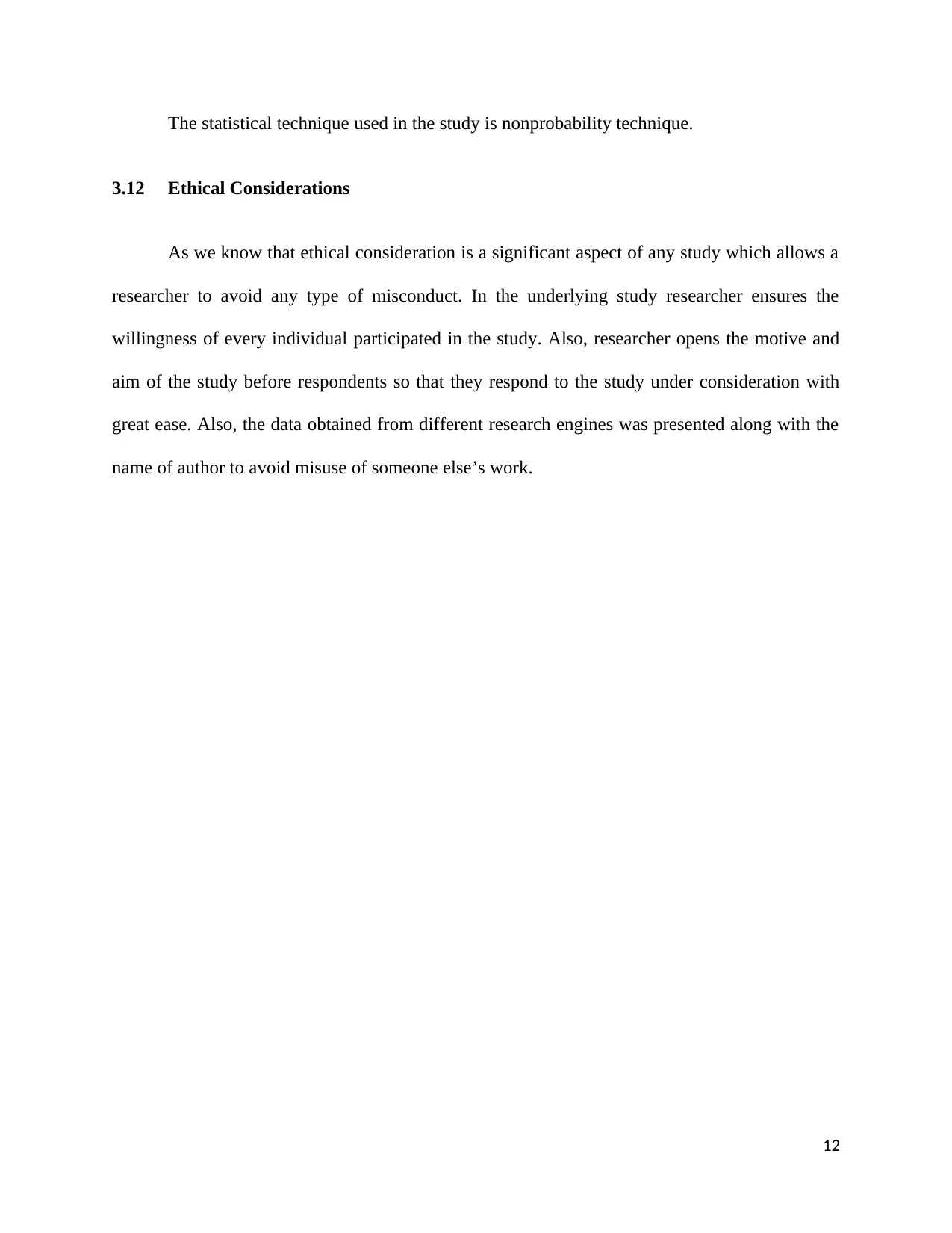
The statistical technique used in the study is nonprobability technique.
3.12 Ethical Considerations
As we know that ethical consideration is a significant aspect of any study which allows a
researcher to avoid any type of misconduct. In the underlying study researcher ensures the
willingness of every individual participated in the study. Also, researcher opens the motive and
aim of the study before respondents so that they respond to the study under consideration with
great ease. Also, the data obtained from different research engines was presented along with the
name of author to avoid misuse of someone else’s work.
12
3.12 Ethical Considerations
As we know that ethical consideration is a significant aspect of any study which allows a
researcher to avoid any type of misconduct. In the underlying study researcher ensures the
willingness of every individual participated in the study. Also, researcher opens the motive and
aim of the study before respondents so that they respond to the study under consideration with
great ease. Also, the data obtained from different research engines was presented along with the
name of author to avoid misuse of someone else’s work.
12
Secure Best Marks with AI Grader
Need help grading? Try our AI Grader for instant feedback on your assignments.
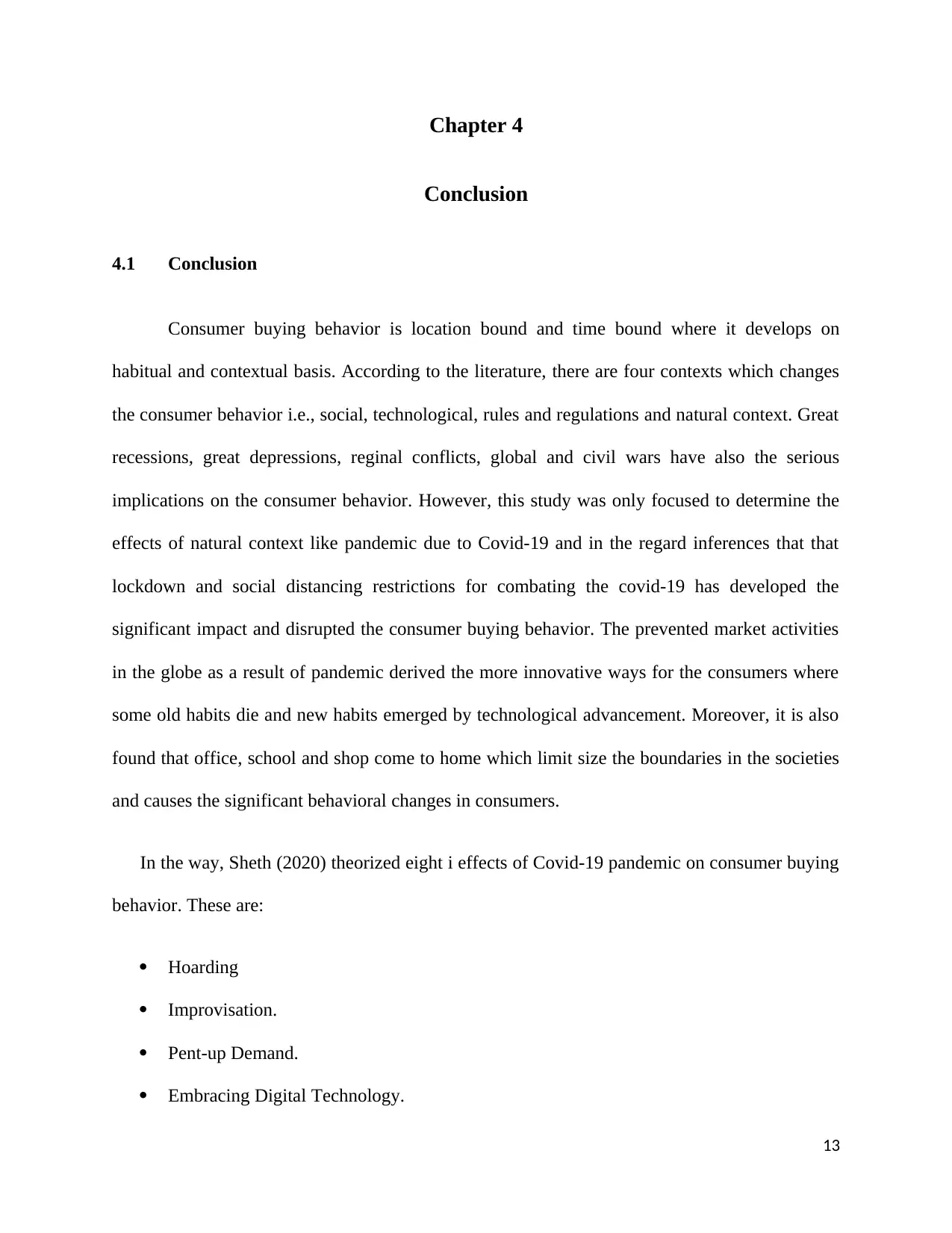
Chapter 4
Conclusion
4.1 Conclusion
Consumer buying behavior is location bound and time bound where it develops on
habitual and contextual basis. According to the literature, there are four contexts which changes
the consumer behavior i.e., social, technological, rules and regulations and natural context. Great
recessions, great depressions, reginal conflicts, global and civil wars have also the serious
implications on the consumer behavior. However, this study was only focused to determine the
effects of natural context like pandemic due to Covid-19 and in the regard inferences that that
lockdown and social distancing restrictions for combating the covid-19 has developed the
significant impact and disrupted the consumer buying behavior. The prevented market activities
in the globe as a result of pandemic derived the more innovative ways for the consumers where
some old habits die and new habits emerged by technological advancement. Moreover, it is also
found that office, school and shop come to home which limit size the boundaries in the societies
and causes the significant behavioral changes in consumers.
In the way, Sheth (2020) theorized eight i effects of Covid-19 pandemic on consumer buying
behavior. These are:
Hoarding
Improvisation.
Pent-up Demand.
Embracing Digital Technology.
13
Conclusion
4.1 Conclusion
Consumer buying behavior is location bound and time bound where it develops on
habitual and contextual basis. According to the literature, there are four contexts which changes
the consumer behavior i.e., social, technological, rules and regulations and natural context. Great
recessions, great depressions, reginal conflicts, global and civil wars have also the serious
implications on the consumer behavior. However, this study was only focused to determine the
effects of natural context like pandemic due to Covid-19 and in the regard inferences that that
lockdown and social distancing restrictions for combating the covid-19 has developed the
significant impact and disrupted the consumer buying behavior. The prevented market activities
in the globe as a result of pandemic derived the more innovative ways for the consumers where
some old habits die and new habits emerged by technological advancement. Moreover, it is also
found that office, school and shop come to home which limit size the boundaries in the societies
and causes the significant behavioral changes in consumers.
In the way, Sheth (2020) theorized eight i effects of Covid-19 pandemic on consumer buying
behavior. These are:
Hoarding
Improvisation.
Pent-up Demand.
Embracing Digital Technology.
13
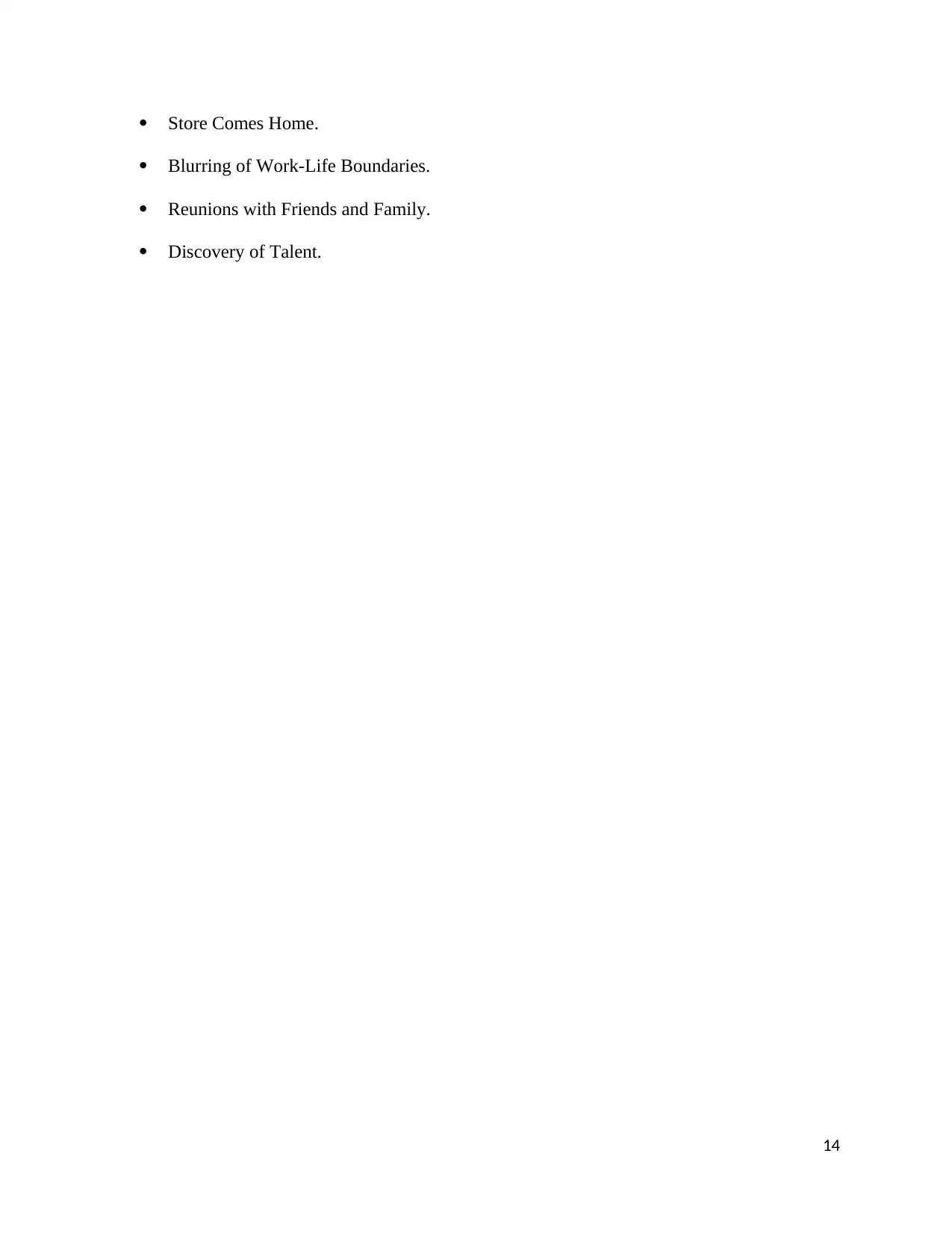
Store Comes Home.
Blurring of Work-Life Boundaries.
Reunions with Friends and Family.
Discovery of Talent.
14
Blurring of Work-Life Boundaries.
Reunions with Friends and Family.
Discovery of Talent.
14
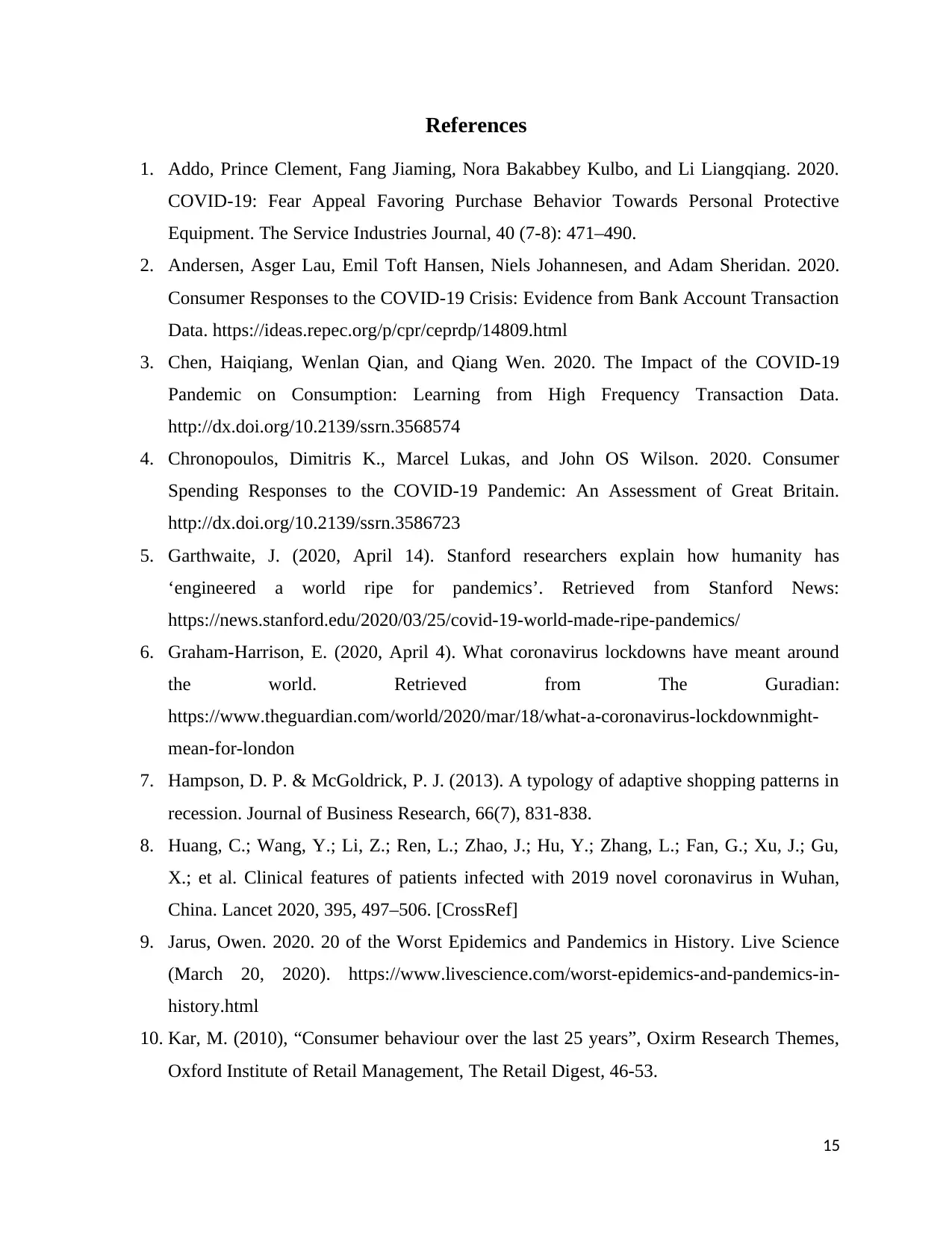
References
1. Addo, Prince Clement, Fang Jiaming, Nora Bakabbey Kulbo, and Li Liangqiang. 2020.
COVID-19: Fear Appeal Favoring Purchase Behavior Towards Personal Protective
Equipment. The Service Industries Journal, 40 (7-8): 471–490.
2. Andersen, Asger Lau, Emil Toft Hansen, Niels Johannesen, and Adam Sheridan. 2020.
Consumer Responses to the COVID-19 Crisis: Evidence from Bank Account Transaction
Data. https://ideas.repec.org/p/cpr/ceprdp/14809.html
3. Chen, Haiqiang, Wenlan Qian, and Qiang Wen. 2020. The Impact of the COVID-19
Pandemic on Consumption: Learning from High Frequency Transaction Data.
http://dx.doi.org/10.2139/ssrn.3568574
4. Chronopoulos, Dimitris K., Marcel Lukas, and John OS Wilson. 2020. Consumer
Spending Responses to the COVID-19 Pandemic: An Assessment of Great Britain.
http://dx.doi.org/10.2139/ssrn.3586723
5. Garthwaite, J. (2020, April 14). Stanford researchers explain how humanity has
‘engineered a world ripe for pandemics’. Retrieved from Stanford News:
https://news.stanford.edu/2020/03/25/covid-19-world-made-ripe-pandemics/
6. Graham-Harrison, E. (2020, April 4). What coronavirus lockdowns have meant around
the world. Retrieved from The Guradian:
https://www.theguardian.com/world/2020/mar/18/what-a-coronavirus-lockdownmight-
mean-for-london
7. Hampson, D. P. & McGoldrick, P. J. (2013). A typology of adaptive shopping patterns in
recession. Journal of Business Research, 66(7), 831-838.
8. Huang, C.; Wang, Y.; Li, Z.; Ren, L.; Zhao, J.; Hu, Y.; Zhang, L.; Fan, G.; Xu, J.; Gu,
X.; et al. Clinical features of patients infected with 2019 novel coronavirus in Wuhan,
China. Lancet 2020, 395, 497–506. [CrossRef]
9. Jarus, Owen. 2020. 20 of the Worst Epidemics and Pandemics in History. Live Science
(March 20, 2020). https://www.livescience.com/worst-epidemics-and-pandemics-in-
history.html
10. Kar, M. (2010), “Consumer behaviour over the last 25 years”, Oxirm Research Themes,
Oxford Institute of Retail Management, The Retail Digest, 46-53.
15
1. Addo, Prince Clement, Fang Jiaming, Nora Bakabbey Kulbo, and Li Liangqiang. 2020.
COVID-19: Fear Appeal Favoring Purchase Behavior Towards Personal Protective
Equipment. The Service Industries Journal, 40 (7-8): 471–490.
2. Andersen, Asger Lau, Emil Toft Hansen, Niels Johannesen, and Adam Sheridan. 2020.
Consumer Responses to the COVID-19 Crisis: Evidence from Bank Account Transaction
Data. https://ideas.repec.org/p/cpr/ceprdp/14809.html
3. Chen, Haiqiang, Wenlan Qian, and Qiang Wen. 2020. The Impact of the COVID-19
Pandemic on Consumption: Learning from High Frequency Transaction Data.
http://dx.doi.org/10.2139/ssrn.3568574
4. Chronopoulos, Dimitris K., Marcel Lukas, and John OS Wilson. 2020. Consumer
Spending Responses to the COVID-19 Pandemic: An Assessment of Great Britain.
http://dx.doi.org/10.2139/ssrn.3586723
5. Garthwaite, J. (2020, April 14). Stanford researchers explain how humanity has
‘engineered a world ripe for pandemics’. Retrieved from Stanford News:
https://news.stanford.edu/2020/03/25/covid-19-world-made-ripe-pandemics/
6. Graham-Harrison, E. (2020, April 4). What coronavirus lockdowns have meant around
the world. Retrieved from The Guradian:
https://www.theguardian.com/world/2020/mar/18/what-a-coronavirus-lockdownmight-
mean-for-london
7. Hampson, D. P. & McGoldrick, P. J. (2013). A typology of adaptive shopping patterns in
recession. Journal of Business Research, 66(7), 831-838.
8. Huang, C.; Wang, Y.; Li, Z.; Ren, L.; Zhao, J.; Hu, Y.; Zhang, L.; Fan, G.; Xu, J.; Gu,
X.; et al. Clinical features of patients infected with 2019 novel coronavirus in Wuhan,
China. Lancet 2020, 395, 497–506. [CrossRef]
9. Jarus, Owen. 2020. 20 of the Worst Epidemics and Pandemics in History. Live Science
(March 20, 2020). https://www.livescience.com/worst-epidemics-and-pandemics-in-
history.html
10. Kar, M. (2010), “Consumer behaviour over the last 25 years”, Oxirm Research Themes,
Oxford Institute of Retail Management, The Retail Digest, 46-53.
15
Paraphrase This Document
Need a fresh take? Get an instant paraphrase of this document with our AI Paraphraser
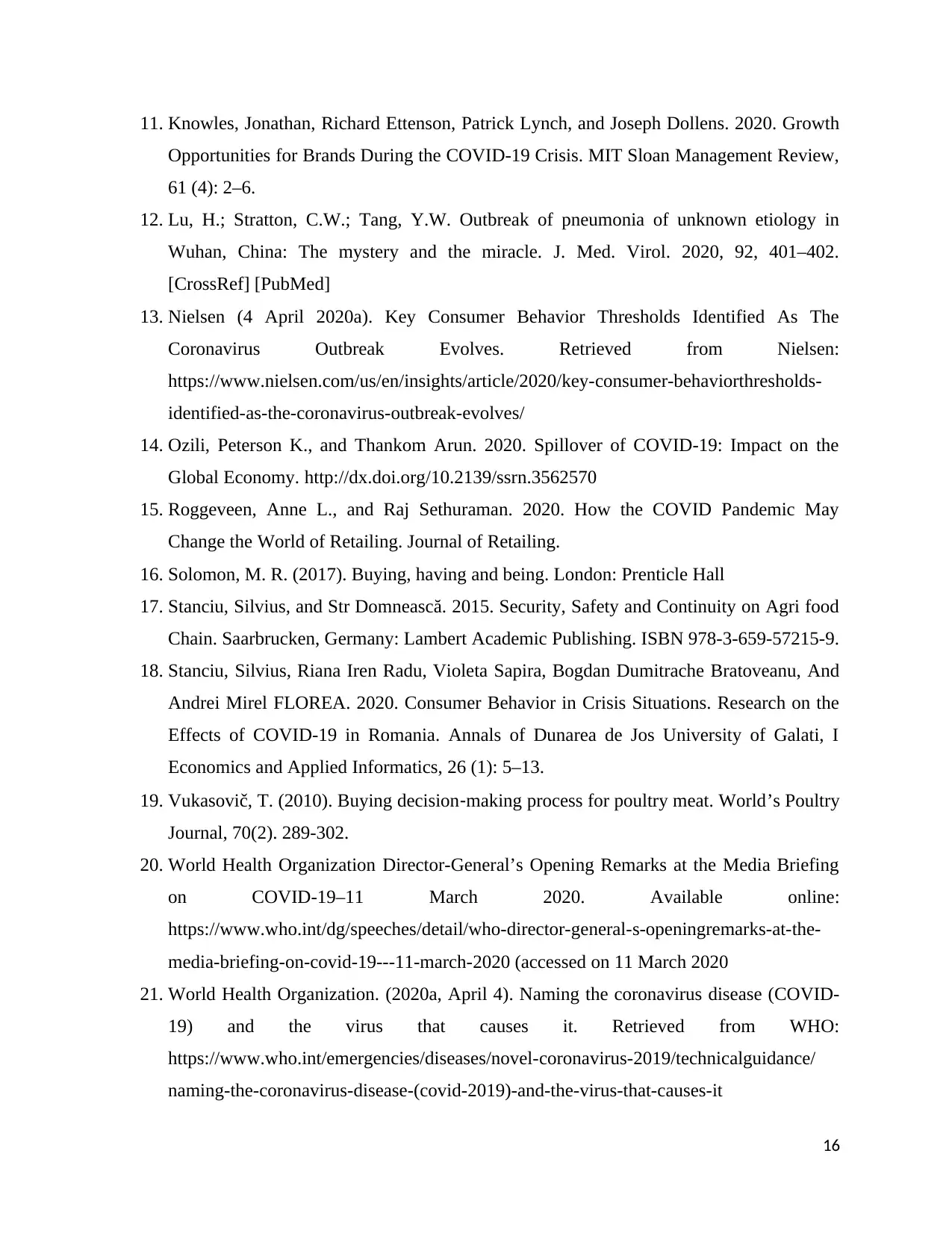
11. Knowles, Jonathan, Richard Ettenson, Patrick Lynch, and Joseph Dollens. 2020. Growth
Opportunities for Brands During the COVID-19 Crisis. MIT Sloan Management Review,
61 (4): 2–6.
12. Lu, H.; Stratton, C.W.; Tang, Y.W. Outbreak of pneumonia of unknown etiology in
Wuhan, China: The mystery and the miracle. J. Med. Virol. 2020, 92, 401–402.
[CrossRef] [PubMed]
13. Nielsen (4 April 2020a). Key Consumer Behavior Thresholds Identified As The
Coronavirus Outbreak Evolves. Retrieved from Nielsen:
https://www.nielsen.com/us/en/insights/article/2020/key-consumer-behaviorthresholds-
identified-as-the-coronavirus-outbreak-evolves/
14. Ozili, Peterson K., and Thankom Arun. 2020. Spillover of COVID-19: Impact on the
Global Economy. http://dx.doi.org/10.2139/ssrn.3562570
15. Roggeveen, Anne L., and Raj Sethuraman. 2020. How the COVID Pandemic May
Change the World of Retailing. Journal of Retailing.
16. Solomon, M. R. (2017). Buying, having and being. London: Prenticle Hall
17. Stanciu, Silvius, and Str Domnească. 2015. Security, Safety and Continuity on Agri food
Chain. Saarbrucken, Germany: Lambert Academic Publishing. ISBN 978-3-659-57215-9.
18. Stanciu, Silvius, Riana Iren Radu, Violeta Sapira, Bogdan Dumitrache Bratoveanu, And
Andrei Mirel FLOREA. 2020. Consumer Behavior in Crisis Situations. Research on the
Effects of COVID-19 in Romania. Annals of Dunarea de Jos University of Galati, I
Economics and Applied Informatics, 26 (1): 5–13.
19. Vukasovič, T. (2010). Buying decision‐making process for poultry meat. World’s Poultry
Journal, 70(2). 289-302.
20. World Health Organization Director-General’s Opening Remarks at the Media Briefing
on COVID-19–11 March 2020. Available online:
https://www.who.int/dg/speeches/detail/who-director-general-s-openingremarks-at-the-
media-briefing-on-covid-19---11-march-2020 (accessed on 11 March 2020
21. World Health Organization. (2020a, April 4). Naming the coronavirus disease (COVID-
19) and the virus that causes it. Retrieved from WHO:
https://www.who.int/emergencies/diseases/novel-coronavirus-2019/technicalguidance/
naming-the-coronavirus-disease-(covid-2019)-and-the-virus-that-causes-it
16
Opportunities for Brands During the COVID-19 Crisis. MIT Sloan Management Review,
61 (4): 2–6.
12. Lu, H.; Stratton, C.W.; Tang, Y.W. Outbreak of pneumonia of unknown etiology in
Wuhan, China: The mystery and the miracle. J. Med. Virol. 2020, 92, 401–402.
[CrossRef] [PubMed]
13. Nielsen (4 April 2020a). Key Consumer Behavior Thresholds Identified As The
Coronavirus Outbreak Evolves. Retrieved from Nielsen:
https://www.nielsen.com/us/en/insights/article/2020/key-consumer-behaviorthresholds-
identified-as-the-coronavirus-outbreak-evolves/
14. Ozili, Peterson K., and Thankom Arun. 2020. Spillover of COVID-19: Impact on the
Global Economy. http://dx.doi.org/10.2139/ssrn.3562570
15. Roggeveen, Anne L., and Raj Sethuraman. 2020. How the COVID Pandemic May
Change the World of Retailing. Journal of Retailing.
16. Solomon, M. R. (2017). Buying, having and being. London: Prenticle Hall
17. Stanciu, Silvius, and Str Domnească. 2015. Security, Safety and Continuity on Agri food
Chain. Saarbrucken, Germany: Lambert Academic Publishing. ISBN 978-3-659-57215-9.
18. Stanciu, Silvius, Riana Iren Radu, Violeta Sapira, Bogdan Dumitrache Bratoveanu, And
Andrei Mirel FLOREA. 2020. Consumer Behavior in Crisis Situations. Research on the
Effects of COVID-19 in Romania. Annals of Dunarea de Jos University of Galati, I
Economics and Applied Informatics, 26 (1): 5–13.
19. Vukasovič, T. (2010). Buying decision‐making process for poultry meat. World’s Poultry
Journal, 70(2). 289-302.
20. World Health Organization Director-General’s Opening Remarks at the Media Briefing
on COVID-19–11 March 2020. Available online:
https://www.who.int/dg/speeches/detail/who-director-general-s-openingremarks-at-the-
media-briefing-on-covid-19---11-march-2020 (accessed on 11 March 2020
21. World Health Organization. (2020a, April 4). Naming the coronavirus disease (COVID-
19) and the virus that causes it. Retrieved from WHO:
https://www.who.int/emergencies/diseases/novel-coronavirus-2019/technicalguidance/
naming-the-coronavirus-disease-(covid-2019)-and-the-virus-that-causes-it
16
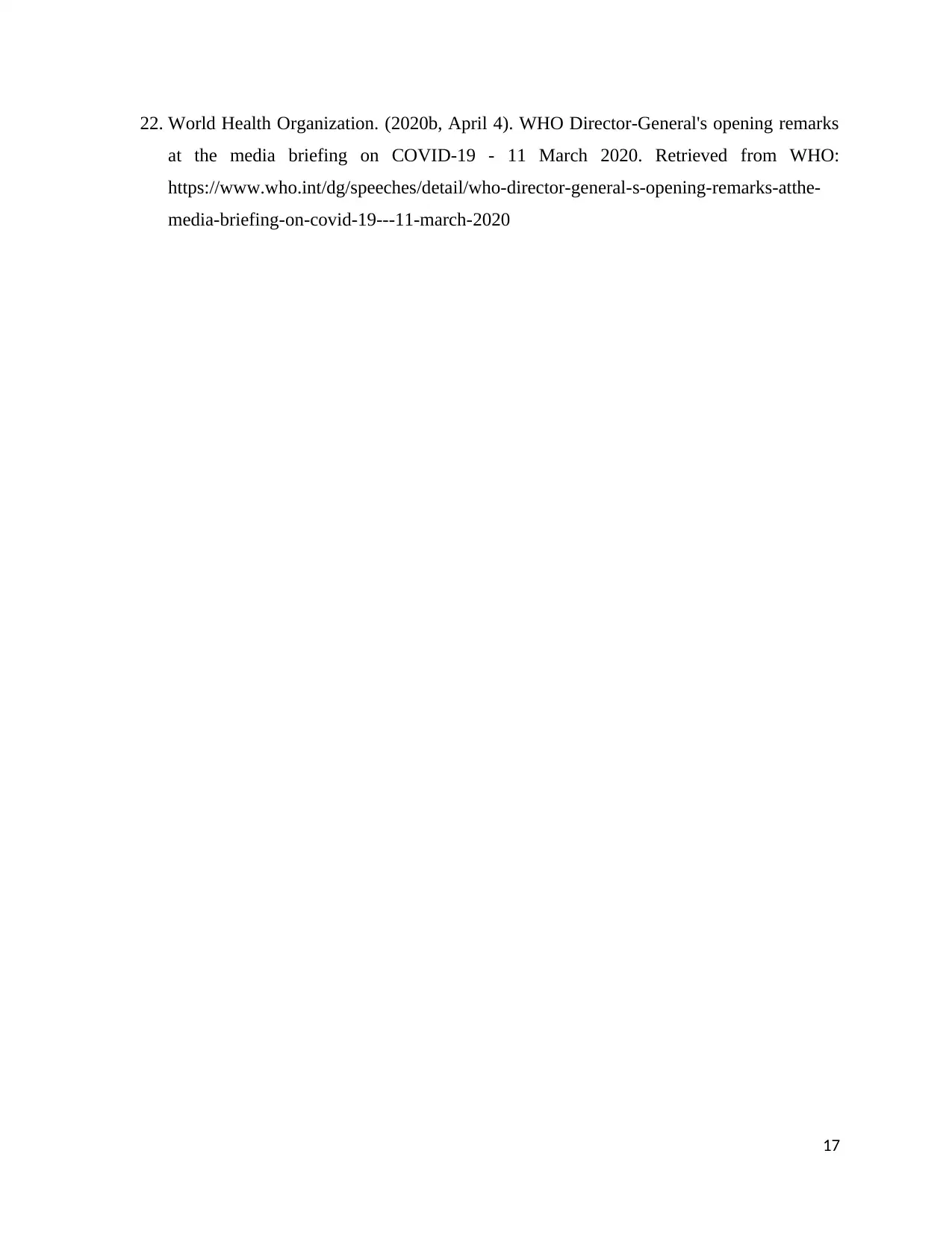
22. World Health Organization. (2020b, April 4). WHO Director-General's opening remarks
at the media briefing on COVID-19 - 11 March 2020. Retrieved from WHO:
https://www.who.int/dg/speeches/detail/who-director-general-s-opening-remarks-atthe-
media-briefing-on-covid-19---11-march-2020
17
at the media briefing on COVID-19 - 11 March 2020. Retrieved from WHO:
https://www.who.int/dg/speeches/detail/who-director-general-s-opening-remarks-atthe-
media-briefing-on-covid-19---11-march-2020
17
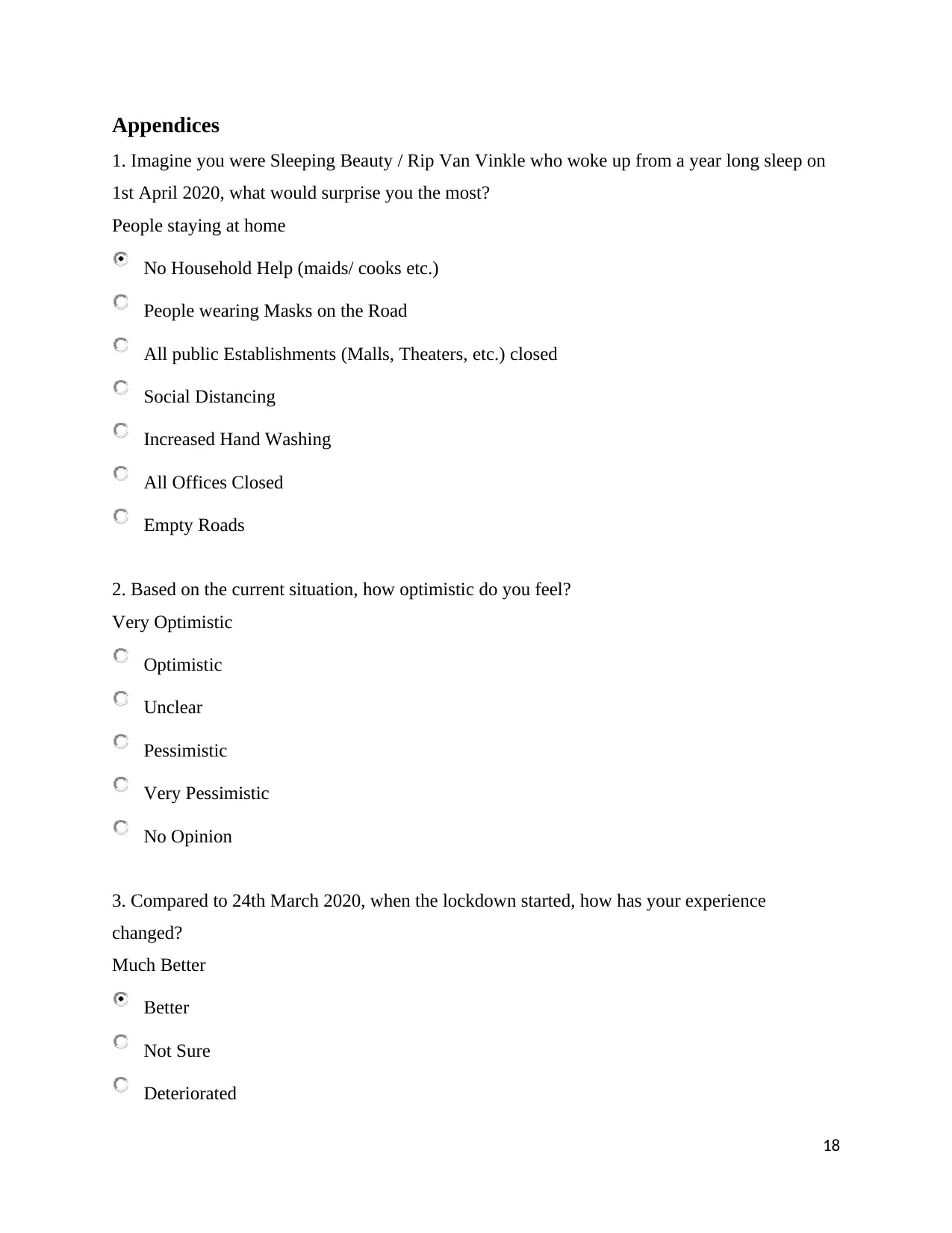
Appendices
1. Imagine you were Sleeping Beauty / Rip Van Vinkle who woke up from a year long sleep on
1st April 2020, what would surprise you the most?
People staying at home
No Household Help (maids/ cooks etc.)
People wearing Masks on the Road
All public Establishments (Malls, Theaters, etc.) closed
Social Distancing
Increased Hand Washing
All Offices Closed
Empty Roads
2. Based on the current situation, how optimistic do you feel?
Very Optimistic
Optimistic
Unclear
Pessimistic
Very Pessimistic
No Opinion
3. Compared to 24th March 2020, when the lockdown started, how has your experience
changed?
Much Better
Better
Not Sure
Deteriorated
18
1. Imagine you were Sleeping Beauty / Rip Van Vinkle who woke up from a year long sleep on
1st April 2020, what would surprise you the most?
People staying at home
No Household Help (maids/ cooks etc.)
People wearing Masks on the Road
All public Establishments (Malls, Theaters, etc.) closed
Social Distancing
Increased Hand Washing
All Offices Closed
Empty Roads
2. Based on the current situation, how optimistic do you feel?
Very Optimistic
Optimistic
Unclear
Pessimistic
Very Pessimistic
No Opinion
3. Compared to 24th March 2020, when the lockdown started, how has your experience
changed?
Much Better
Better
Not Sure
Deteriorated
18
Secure Best Marks with AI Grader
Need help grading? Try our AI Grader for instant feedback on your assignments.
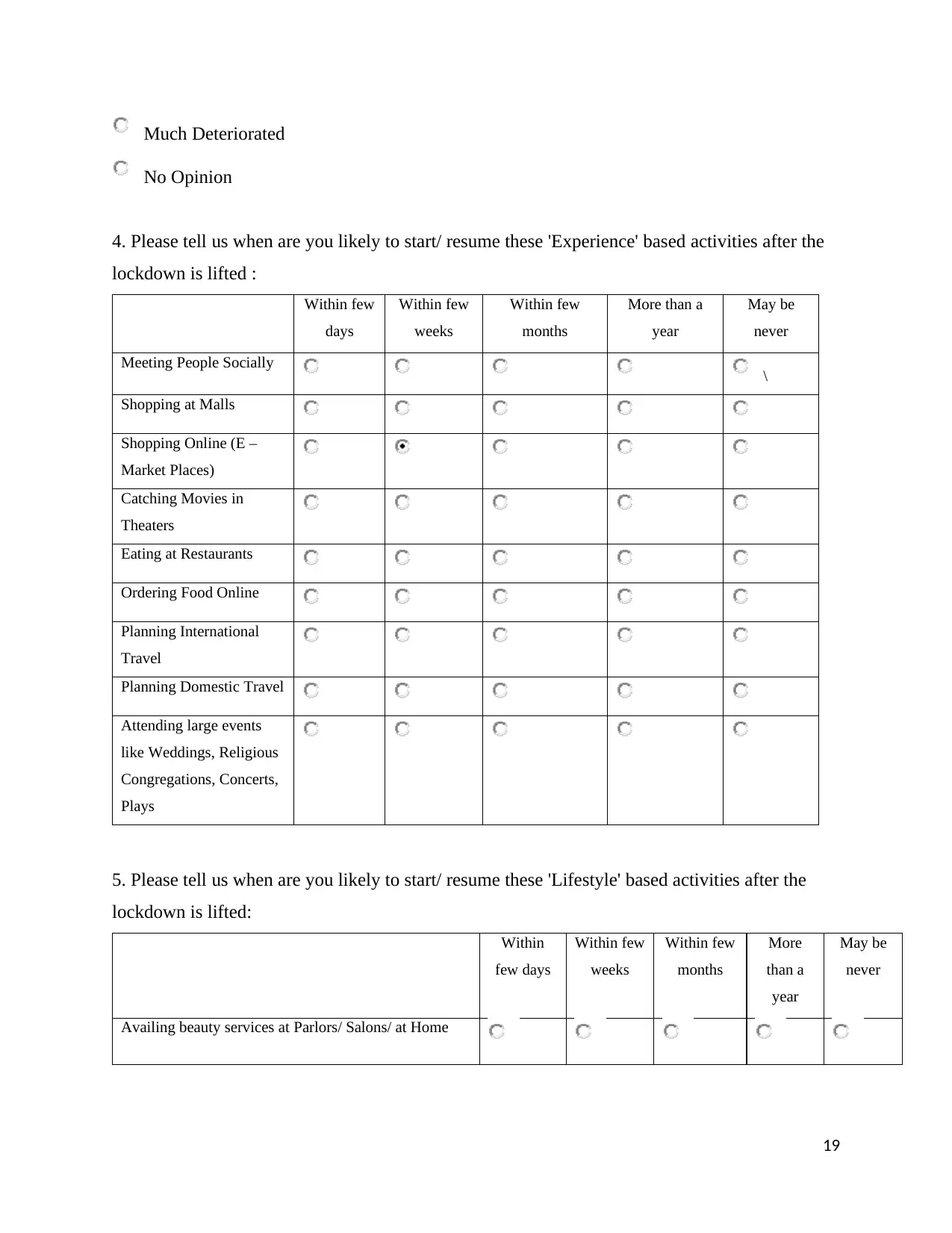
Much Deteriorated
No Opinion
4. Please tell us when are you likely to start/ resume these 'Experience' based activities after the
lockdown is lifted :
Within few
days
Within few
weeks
Within few
months
More than a
year
May be
never
Meeting People Socially \
Shopping at Malls
Shopping Online (E –
Market Places)
Catching Movies in
Theaters
Eating at Restaurants
Ordering Food Online
Planning International
Travel
Planning Domestic Travel
Attending large events
like Weddings, Religious
Congregations, Concerts,
Plays
5. Please tell us when are you likely to start/ resume these 'Lifestyle' based activities after the
lockdown is lifted:
Within
few days
Within few
weeks
Within few
months
More
than a
year
May be
never
Availing beauty services at Parlors/ Salons/ at Home
19
No Opinion
4. Please tell us when are you likely to start/ resume these 'Experience' based activities after the
lockdown is lifted :
Within few
days
Within few
weeks
Within few
months
More than a
year
May be
never
Meeting People Socially \
Shopping at Malls
Shopping Online (E –
Market Places)
Catching Movies in
Theaters
Eating at Restaurants
Ordering Food Online
Planning International
Travel
Planning Domestic Travel
Attending large events
like Weddings, Religious
Congregations, Concerts,
Plays
5. Please tell us when are you likely to start/ resume these 'Lifestyle' based activities after the
lockdown is lifted:
Within
few days
Within few
weeks
Within few
months
More
than a
year
May be
never
Availing beauty services at Parlors/ Salons/ at Home
19
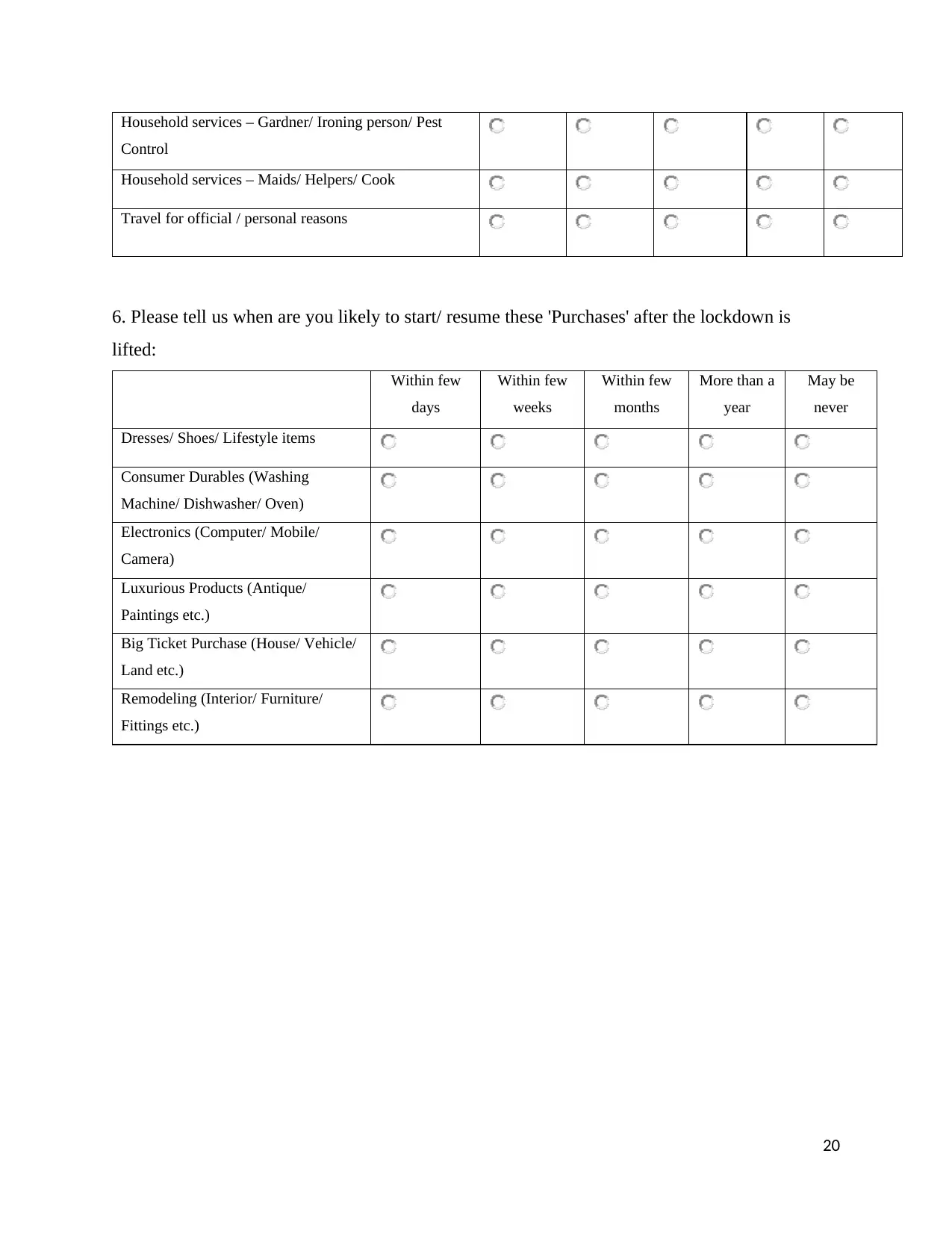
Household services – Gardner/ Ironing person/ Pest
Control
Household services – Maids/ Helpers/ Cook
Travel for official / personal reasons
6. Please tell us when are you likely to start/ resume these 'Purchases' after the lockdown is
lifted:
Within few
days
Within few
weeks
Within few
months
More than a
year
May be
never
Dresses/ Shoes/ Lifestyle items
Consumer Durables (Washing
Machine/ Dishwasher/ Oven)
Electronics (Computer/ Mobile/
Camera)
Luxurious Products (Antique/
Paintings etc.)
Big Ticket Purchase (House/ Vehicle/
Land etc.)
Remodeling (Interior/ Furniture/
Fittings etc.)
20
Control
Household services – Maids/ Helpers/ Cook
Travel for official / personal reasons
6. Please tell us when are you likely to start/ resume these 'Purchases' after the lockdown is
lifted:
Within few
days
Within few
weeks
Within few
months
More than a
year
May be
never
Dresses/ Shoes/ Lifestyle items
Consumer Durables (Washing
Machine/ Dishwasher/ Oven)
Electronics (Computer/ Mobile/
Camera)
Luxurious Products (Antique/
Paintings etc.)
Big Ticket Purchase (House/ Vehicle/
Land etc.)
Remodeling (Interior/ Furniture/
Fittings etc.)
20
1 out of 24
Related Documents
Your All-in-One AI-Powered Toolkit for Academic Success.
+13062052269
info@desklib.com
Available 24*7 on WhatsApp / Email
![[object Object]](/_next/static/media/star-bottom.7253800d.svg)
Unlock your academic potential
© 2024 | Zucol Services PVT LTD | All rights reserved.





